Movie Review By: SFAM
Directed by: Michael Winterbottom
Written by: Frank Cottrell Boyce
IMDB Reference
Degree of Cyberpunk Visuals: Low
Correlation to Cyberpunk Themes: High
Key Cast Members:
William Geld: Tim Robbins
Maria Gonzales: Samantha Morton
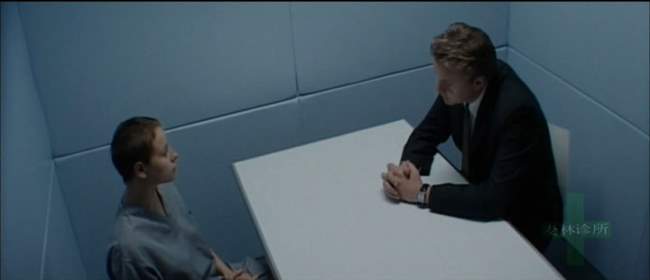
Overview: Code 46 is a movie that generates significant disagreement on ratings. The pacing is glacially slow, but there are enough interesting ideas that many viewers will really dig the final product. Viruses as transhuman upgrades, memory removal, and problems brought on by mass cloning all are mashed together to give an interesting, but somewhat incoherent view of a near-term dystopic future. The cinematography is interesting, and the story itself may end up working well enough for some to enjoy the final product.
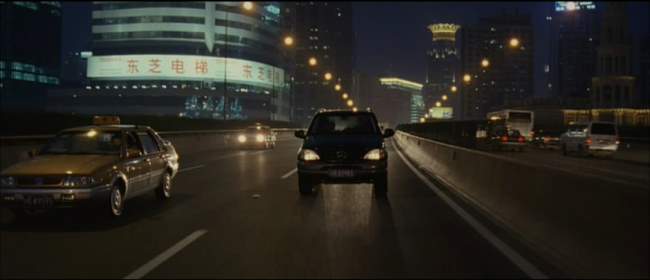
The Setting: Code 46 takes place in a non-specific near future, where overpopulation and degradation of the earth have led to a situation where cities have become protected entities. The population is now divided into those living in the outside and those citizens who have rights to live within. Each city has restricted access – a person is required to have “papelles” (a valid passport/visa) to enter. For some reason, even though there is massive overpopulation, cloning has been used in an overabundant fashion. There is even a law, Code 46, which restricts the relations between those who are genetically similar. Viruses have been genetically engineered to allow new capabilities for people, but also have become so deadly that people must have a valid insurance policy to stay in the city.
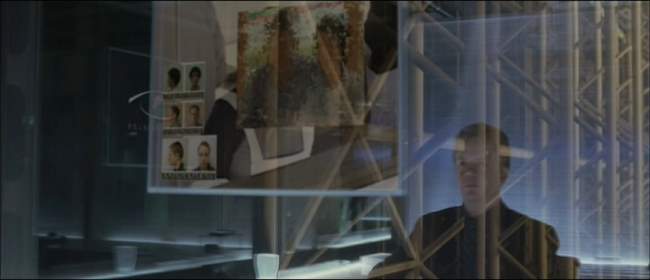
The Story: William Geld, played by Time Robbins, is an insurance investigator imbued with an empathy virus, who’s been tasked to track down a forged papelle ring in Shanghai. Shortly after arriving, William quickly determines that the guilty party is a worker named Maria Gonzales (Samantha Morton), but he doesn’t turn her in. For some reason, even though he is happily married, he is strangely attracted to Maria, so he falsely implicates someone else. After following her home, Maria and William become fall for one another. William leaves the next day for home, but is brought back a few weeks later when the forged papelles continue to be produced. He decides to turn Maria in, but she has left. After investigating, he finds that she had incurred a code 46 violation. William fears that he is the genetically similar party and sets off to find her.
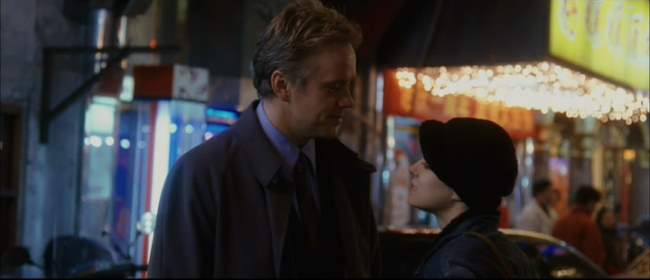
The Acting: Director Michael Winterbottom seems to be going for a Lost in Translation type vibe, but this feel doesn’t really work very well. The leads both turn in believable performances, but something is missing. While the world certainly has an alienated feel, there’s never a sense that the chemistry William and Samantha is strong enough to support a “genetic attraction.” It’s all cerebral. Unfortunately, with the rediculously slow pacing of the movie, this merely adds disconnectedness with the audience.
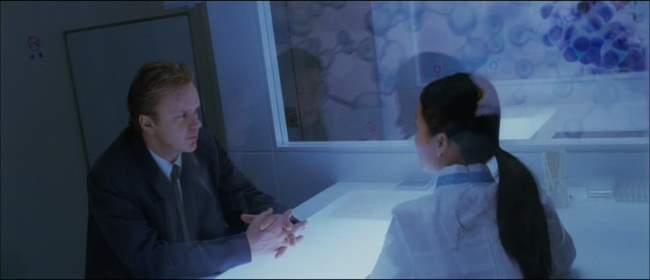
Viruses as Genetic Upgrades: In Code 46, custom made viruses are used for short to long term sensory upgrades. William has an “empathy” virus which allows him to read people’s thoughts. Other viruses allow skills to be developed. The weird thing about the use of viruses as an idea for genetic manipulation is that it causes all sorts of dangerous linkages. For instance, viruses can be passed on, and worse, can change over time. This, I think, is why insurance may play such a large role in Code 46, and why the cities are cordoned off (again, this isn’t really explored all that well). It does make you wonder though, how exactly will genetic manipulation be used in the future? If we are to look for transhuman-like upgrades, are we going to be purchasing an ensemble of cocktail viruses?

Futuristic Low-budget Worldbuilding: Without a large budget, and the absence of CG, director Winterbottom struggles to make his world look futuristic. Mostly based on locations, Winterbottom also emphasizes pastel florescent shades to indicate futurism. Pastel florescent pinks, greens, and blue tones are used in most of the otherwise normal looking city scenes. The outside world is mostly desert, apparently brought on by the effects of global warming, whereas the people all dress like they’re in New Dehli. The night scenes are generally neon shots of Shanghai, which sort of fit in the cyberpunk, near-future genre. Still, there are glaring problems which break suspension of disbelief, where the futuristic world looks identical in most places. The most obvious one deals with the liberal use of modern day cars - apparently the auto industry got laid off after 2003. A cheap solution would have been to jimmy up a few futuristic fiberglass bodies to stick on-top of a jeep or VW, but instead, we are almost left with an alternate view of the present.
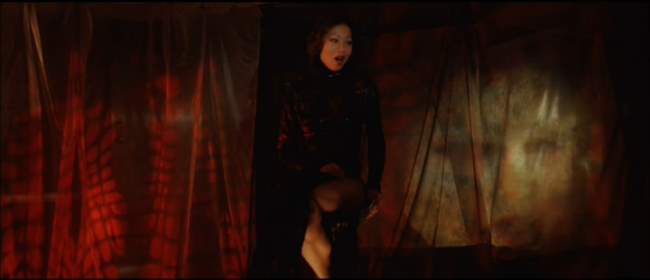
Cyberpunk Tower of Babel – the Creole Merging of Languages: In Code 46, English seems to be the only language used, but it has been “creoled” in that many of the words have been replaced with words from other languages. Boy and girl is now chico and chica; paper is now papelle; hello has been transformed to “meehow”; discontinued is now discontinuago. The cool part about this is how naturally the actors work the word changes into the dialogue. The problematic part of this is that within 50 years or less, the world (even if only the industrial parts) would transform into a single language. If there even is a trend toward this, I think we’d be looking more like 300-500 years for a place like Shanghai to do away with their native Chinese. The more interesting question this raises though is the issue of whether the human race is moving toward a reverse Tower of Babel, or whether the local cultures will become more entrenched as a defense against a globalized language and culture. The world is getting smaller all the time – the implications of this are far from understood right now.
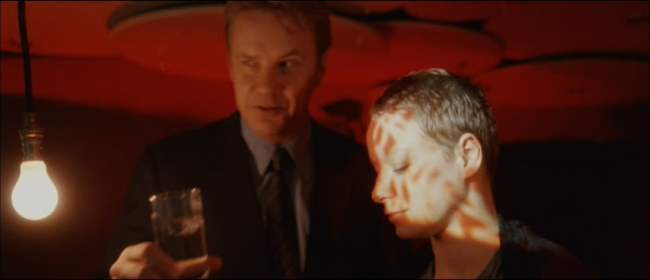
Cyberpunk Oedipus Complex: Harkening back to Freud, Code 46 explores the issue of a man in love with his mother. In Code 46, this connection is so strong that it exists even when the relationship itself is not known to the participants. Personally, I never bought into anything as generalized as Freud’s Oedipus complex, and I don’t know that it works all that well here. But the genetic/cloning slant to this question certainly raises some interesting thoughts. Still, with the advent of overpopulation, its hard to see why people would resort to making an abundance of clones. Perhaps for nefarious thoughts such as body replacement parts, but it would be a stretch for an overpopulated world to create massive versions of the same person. Based on the huge insurance slant in Code 46, we might assume it had something to do with contaminated bodies, but like so many other aspects of this future world, this is never really explained.
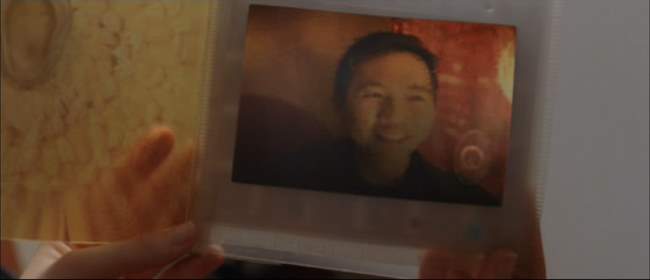
Removal of Memories: The idea of memory modification and their removal has been explored in other movies (Eternal Sunshine of the Spotless Mind, for instance), but the general question is probably similar. Are memories discrete entities that can be targeted and wiped out, or is something more organic going on? Also, if your spouse cheats on you, will a future option for conflict resolution be to simply have the memories of the offending person and the deed itself removed? If so, would you still think your spouse cheated?
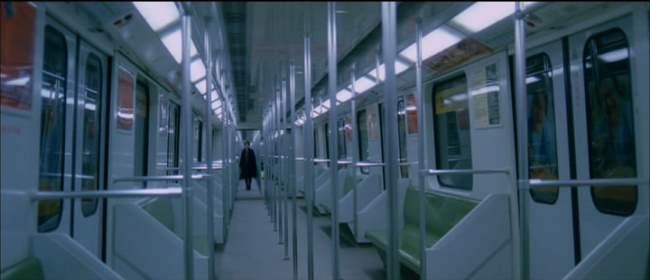
The Bottom Line: Although the plot runs at a glacial pace, and the chemistry between the actors is stilted at best, the inclusion of interesting thoughts, however haphazard, potentially make Code 46 worth a watch. I would have liked to see a bit more clarity on the basis for the technology selections, and definitely would have liked to see more emotive chemistry between the leads. The “Lost in Translation” vibe just doesn’t work here all that well. Bottom line, if you’re someone who doesn’t mind watching interesting looking paint dry, you might end up liking Code 46.
~See movies similar to this one~
Movie Review By: SFAM
Year: 2006
Directed by: Christian Volckman
Written by: Alexandre de La Patellière, Mathieu Delaporte, et al.
IMDB Reference
Degree of Cyberpunk Visuals: Very High
Correlation to Cyberpunk Themes: Medium
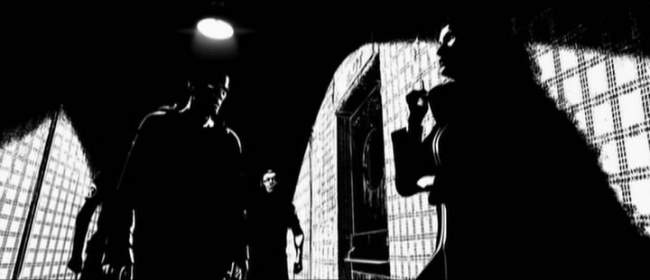
Overview – Good luck in finding a copy! Once upon a time, Renaissance was one of my most anticipated movies of 2006. Originally released in France on March 15th, I eagerly awaited its September release in the US. My anticipation was heightened in that I was even contacted by Miramax representatives as part of a pre-hype blitz. So imagine my surprise when its release in the US only comprised a few select cities – unfortunately my city didn’t make the cut (thanks Miramax!). Similar to so many other good, but foreign science fiction and fantasy flicks, instead of getting a nice theatrical viewing, I was yet again forced wait and then later buy an import (or pirated – sometimes you just aren’t sure) DVD off of eBay. If you are in the US and are interested in seeing Renaissance, chances are you’re in the same boat. One would have hoped that a movie as visually stunning as Renaissance would have been at least able to quality for a DVD release, but clearly something larger is going on here as many other foreign genre films are in the same boat.
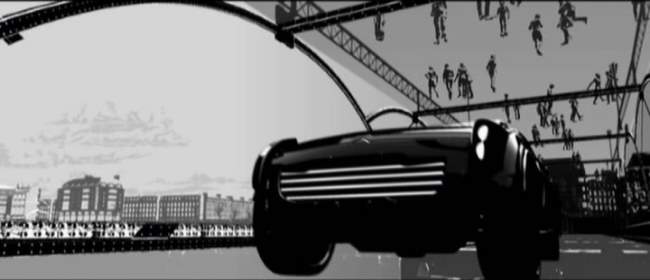
The Setting: In the year 2054, mega-corporations are all-powerful, with tentacles in all aspects of life. The divisions between rich (megacorps) and poor are greater than ever. Paris has grown in layers, with high-tech buildings pushing every further into the sky. Although the city is sleek and stylish, most people live a pathetic existence. In Paris, the Avalon Corporation rules the cityscapes. The police force is not immune from their pressures, and often become their lackeys.

The Story: When a promising young biogeneticist named Ilona (voiced by Romala Garai) from the Avalon Corporation is kidnapped, detective Barthélémy Karas (Daniel Craig) and his team are brought in to investigate. As Karas interviews all the key players, it becomes clear that this isn’t a simple missing person case, as the details of the disappearance become increasingly more bizarre and complicated. The Avalon corporation president, Dellenback (Jonathan Pryce), not known for his loyalty to his workers, is extremely interested in her return. Ilona’s bioengineering mentor has a strange past, and stopped doing research after an accident from 2006. Karas befriends Ilona’s older sister, Bislane (Catherine McCormack), who tells of a stolen book.

Similar to Howard Hawks’ “The Big Sleep” (1946), Karas spirals back and forth between the key players as more clues are provided. Karas uncovers a darker side of the Avalon Corporation, and of Ilona’s mentor, Dellenback. Furthermore, it appears that the secret to immortality has been discovered, and is tied to Ilona herself. As Karas and Bislane continue searching for Ilona, the list of enemies grows. The key players are getting offed, Karas is booted from the force, and is now in fear of his life. Worse, they are discovering that humanity itself may be at risk if Ilona is found.

The Characters: It’s not a stretch to say that virtually every character in Renaissance comes “cookie cutter” from the old noir movies, with a nice slice of traditional cyberpunk thrown in the mix. From the honest but jaded crusty cop with a soft spot to the megalomaniac mega-corporation leader, to the shady friend the cop goes to when he needs a favor to the femme fatale; don’t expect freshness, because it isn’t coming. Like the old noirs, everyone in Renaissance is flawed; everyone is gray – which does make for an interesting contrast when transposed on such stark black and white animation.
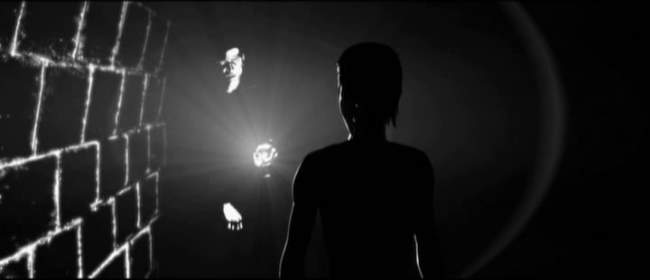
The Atmosphere: While the story falls short, the look of Renaissance fully original and is flat-out amazing. If Renaissance is best described as style over substance, the style really comes STRONG to the party. Stark black and whites dominate virtually every shot. Shadows are in abundance, and usually highlight the main action points. Gray is used sparingly, and is usually applied to change the mood of the scene. To its credit, Volckman succeeds at creating a near-future world that is deeply flawed but not overly futuristic. The cityscapes are incredibly detailed, and give the impression that there are always a bevy of interesting happenings occurring. A transparent glass-like substance is now used to make walkways above and below the roads – this more than anything creates a sleek, near-future ambience. The stark black and white look of Renaissance works well both in the daylight and evening shots, both having shadows prominently placed in virtually every frame.

Traditional cyberpunk conventions are often applied, including huge billboards of beautiful women that extol the virtues of the Avalon Corporation. Avalon fills the role of the dominating mega-corporation that owns and controls virtually everything in Paris. Nothing is beyond their grasp. The police are on their payroll, and the entire city appears to be under surveillance. Immortality, derived through advances in bioengineering (initially undertaken by a Japanese scientist) is the dominating technology intended to challenge God’s position over humanity.

Similarities with Sin City: Volckman stated he was interested in creating a visual feel similar to what one might get when looking at a painting. In terms of what was produced, yes, the look is definitely similar, but Renaissance is not copying Sin City. Although Sin City came out first, Renaissance started its production far before Sin City. In terms of look, Renaissance really does match very closely with the Sin City graphic novels – more so than Sin City in fact. But while it also is a neo-noir, the dialogue and mood of Renaissance is far more like a corporate espionage version of a standard 40s detective noir (think “The Big Sleep” with corporations instead of the mob), whereas Sin City had more of a hyper-real, over-the-top neo-noir feel.
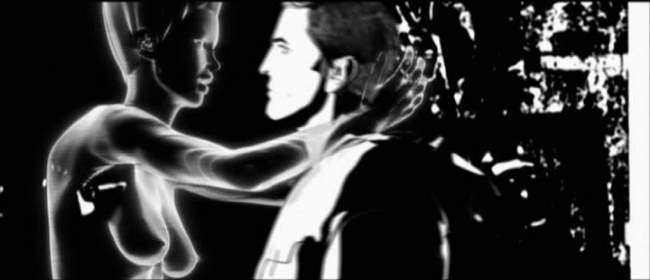
The Animation: Using an innovative motion-capture to rotoscope approach, where 24 cameras are used when shooting the actors, Volckman was able to work on the framing and viewpoint well after the shoot was complete, and then paint on the black and white animation. Unlike Linklater’s rotoscoping, where the actors’ faces and body appear to be constantly shifting, the level of precision used in Renaissance is significantly higher. When moving, the sprite’s actions are incredibly human-looking. There is a slight lag though when they first take action – a noticeable lag that’s slower than you would expect a person’s actions to be.

The Technology: While the basic story for Renaissance is straight cyberpunk neo-noir, the technology options provided are numerous and fairly interesting. Most visually arresting was the Holodeck sphere prison where Ilona is kept. Karas had a very advanced cybernetic eye implant that allowed him to identify people through solid objects – it also was able to be hacked by Avalon, the Mega-corporation. Computers are slick, now often just the size of a pen with a virtual display that arises upon command. Biotechnological modifications are in vogue, although not at the level of Ghost in the Shell. Similar to Motoko’s invisibility suit, the goons at Avalon have similar suits, although they look more like the soldiers in Jin-Roh than they do the hawt, naked Motoko. Holograms are now used in combination with pictures to remember people and events – in some cases, holograms interact with their human counterparts.
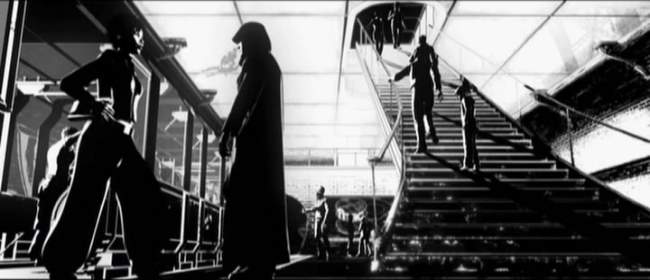
Do you Want to Live Forever? One thesis of Renaissance is the notion that immortality, if invented, would destroy humanity. Not a lot of backing is provided for this idea, but the idea put forward is that this irrevocable change in the hands of a mega-corporation would provide a method of control so powerful that society would no longer function. This is all the more interesting in that some are predicting that humanity will have the equivalent of immortality within the next 50 years. If this comes to pass, will the possibility of immortality be distributed evenly or will this be a tool of domination similar to in Renaissance?
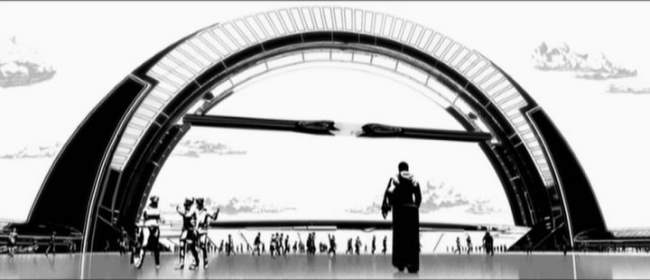
The Bottom Line: Although the story and characters are not original, the animation and overall cinematography is both innovative and outstanding, and should not be missed. There is truly something unique in the look here that you just won’t find anywhere else. The voice and motion acting are more than passable and Nicholas Dodd’s score provides a wonderful combination of a 007 espionage flick with the haunting eeriness of the score from Stargate. As icing on the cake, the science, technology and architecture exhibited in Renaissance will make you think. It may be hard to find, but it’s well worth the time spent looking for it.
Page 2, More Screencaps–>
~See movies similar to this one~
Movie Review By: SFAM
Year: 2002
Directed by: Kurt Wimmer
Written by: Kurt Wimmer
IMDB Reference
Degree of Cyberpunk Visuals: High
Correlation to Cyberpunk Themes: Medium
Key Cast Members:
Cleric John Preston: Christian Bale
Dupont: Angus Macfadyen
Errol Partridge: Sean Bean
Brandt: Taye Diggs
Jürgen: William Fichtner
Mary O’Brien: Emily Watson
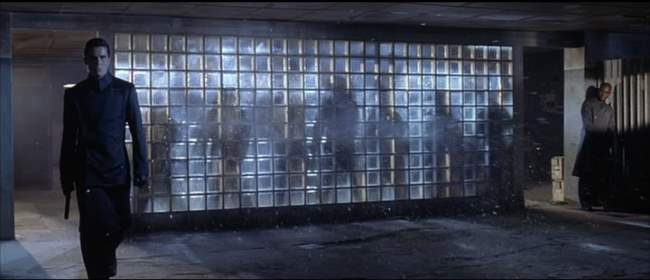
Overview: Equilibrium is one of those movies that most everyone who knows of it has only seen it on DVD. Essentially thrown away by its studio, Equilibrium, created for a budget just over 20 million was given no dollars for marketing and made less than a million at the box office. But don’t let that sway you into thinking this movie is a piece of trash. Equilibrium has become a cult DVD hit. Made in Eastern Germany portion of Berlin, Equilibrium looks lots more substantial than the 20 million that went into it. Due to some terrific location choices, Equilibrium shines with a polish of a movie made for at least twice that budget. This, plus high quality acting and at least a modicum of interesting thought raise Equilibrium up from the pop-FX action-fest that it otherwise might have become.
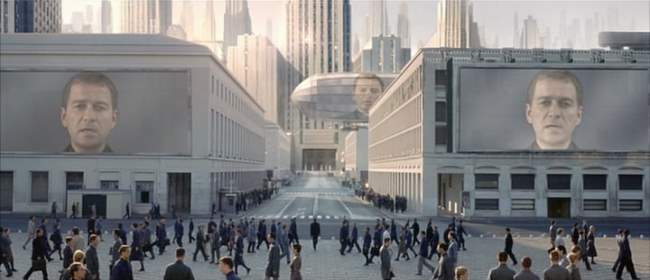
The Setting: Set sometime in the 21st century, after a massive nuclear war has wiped out the majority of the human race, a 1984 style society has emerged after a method of full population control was discovered. The entire population is now given a daily dose of a drug called of Prozium. Prozium removes all semblances of emotion, and leaves the populace docile and controlled. Exhibiting emotion is now considered the greatest of all crimes, and is punishable by death. The all-knowing, all-controlling “Father” has constructed a group of supra-police called “clerics” who spend their time seeking out “sense offenders” and burning all remnants of the old way.
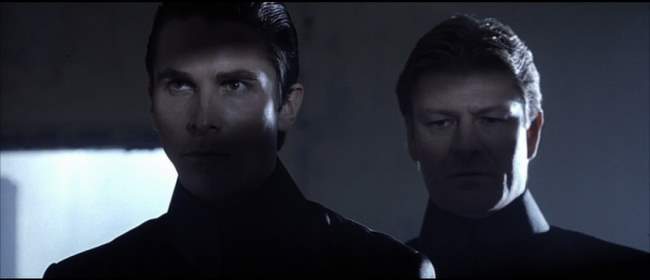
The Story: Cleric John Preston (starring Christian Bale) is among the best cleric enforcers. Along with his partner, Errol Partridge (Sean Bean), they spend their days burning heretical artifacts like the Mona Lisa and bringing sense offenders in for processing – a euphemism for baking people in a large oven. Unfortunately, Partridge has begun to have doubts about society, and has apparently stopped taking the drug. After Preston finds out and kills him, Partridge’s final thoughts compel Preston to revisit his own personal history in which he showed no emotions as his wife was burned for sense making. Preston begins to question the intense surveillance society.
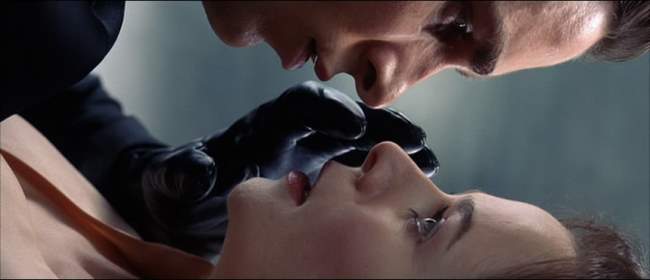
In tracking down Partridge’s lover (Emily Watson), Preston’s world finally crumbles. Now he realizes he has presided over the destruction of humanity, and can no longer continue. Unfortunately, Dupont (Angus Macfadyen), the mouthpiece of the Father and leader of the Clerics has asked Preston to infiltrate the remainder of the resistance in order to crush them once and for all. But Preston is actually approached by the resistance leader, Jürgen (William Fichtner) who has noticed his recent spate of emotion. While Preston is still conflicted, Jürgen tries to enlist Preston in destroying the Father. Even worse, Preston’s ambitious new partner, Brandt (Taye Diggs) strongly suspects Preston of becoming a sense offender.
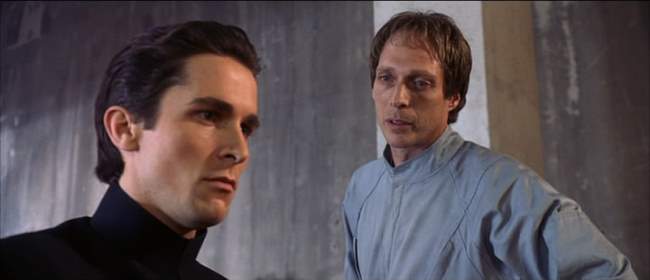
The Acting: The acting in Equilibrium is top notch. For my money, the best performance is turned in by Sean Bean, who, while only on screen for a brief time, really hammers home the essence of the message Equilibrium is conveying. But truly, all the main cast is terrific. Bale does a very good job in going through a conversion in losing his faith, while Fichtner, Macfadyen, Diggs and Watson all really add real believability to a somewhat forced story. Truly, the acting sets Equilibrium above a better than average genre movie to something really worth watching.
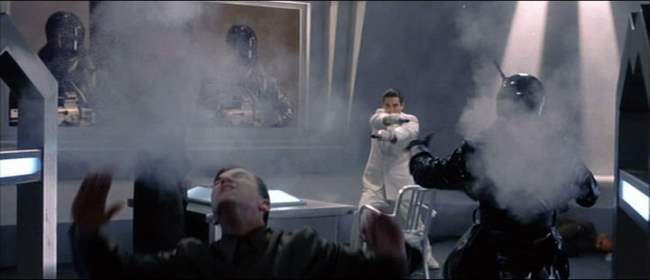
The Action - GunKata: Gunkata is Kurt Wimmer’s newly invented martial art – gun combat in close quarters. The idea is that body positioning and fluid movements, along with an intense understanding of one’s opponents’ most likely actions will allow the Gunkata master – Clerics, in Equilibrium – to be close to unstoppable. Many times in Equilibrium, Preston goes into a room LOADED of bad guys and wipes them all out. Does it look in the least realistic? Not at all, but it does look cool. The action sequences are hectic by design, but are always well planned out and executed. Even if you could care less about the message, if you like gun fighting, Equilibrium is for you!
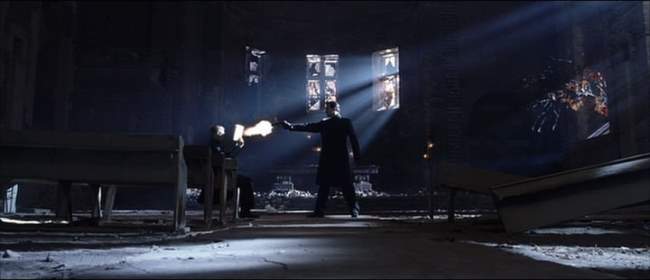
The Visuals: The color of the day for Equilibrium is black, gray and occasionally white. Virtually everything is in black with brief highlights. This makes the instances where other colors are used, such as Preston’s Bruce Lee white outfit near the end of the picture, or the yellow sunset as seeming enormously more significant than they normally would seem. The other dominant theme is squared off architecture. Everything here is comprised of right angles to emphasize the controlled, boxed-in feel of the society. Even worse, the only prominent place that a circle appears is the processing factory, where sense-offenders are burned. Wimmer uses his most excellent set selections to optimal effect. The Cinematography choices always go for high shadows and contrasts, and usually come from interesting angles and contexts. Without trying to resort to high-tech wizardry, the world Wimmer ultimately creates is believable and otherworldly.
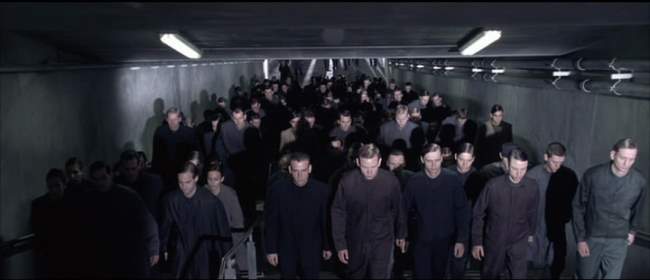
Centralized Control and the Surveillance Society: While the message is often obscured by the slick visuals and action sequences, Equilibrium’s basis is right out of the Metropolis, 1984 model. In looking at a situation where humanity has gone awry, the corrective procedure is one which divorces people from that which makes them human – their emotions. In this model, emotion control leads to thought control, which yields a smooth, functioning society. The warning is clear – if we move down a road that involves giving up our personal freedom, the danger is that we lose our technology. If I were to point out quibbles with this, the idea of the single, evil genius behind all of everything bad lessons the impact. The message conveyed is that society slowly made the choice to go this route – it would have been better to see remnants of that choice still guiding the society versus the simple “glorious leader” bad guy.
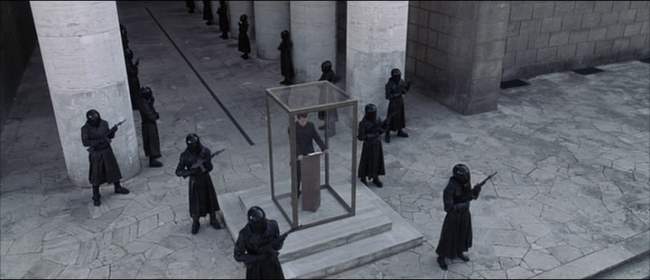
Is There Any Relevance to Today’s World? While only briefly mentioned by Sean Bean’s character, Partridge discusses the “trade off” that humanity made. In exchange for security and stability, they agreed to trade away their freewill. One gets the sense that this was a slow process at first, but which picked up dramatically once centralized control was present. While it’s a far stretch to imagine an emotion blocker being instituted, if we imagine freewill as a sliding scale, its clear that the debate between our personal freedoms and societal security measures are clashing right now. One can only imagine how much greater support the security side would be if in fact a nuclear conflict did break out. Unfortunately, this too is becoming far more likely – in 20 years, we can certainly envision that the number of groups and governments in possession of nuclear material will be far greater than today. The risk isn’t just that a small group of terrorists will use it. Unfortunately, pre-emption of conflict by larger countries could also lead to such a response. In short, as the concern for security and stability are greater, the pressure to impact personal freedoms will grow. If this isn’t a key ingredient for the creation of a cyberpunked world, I don’t know what would be.
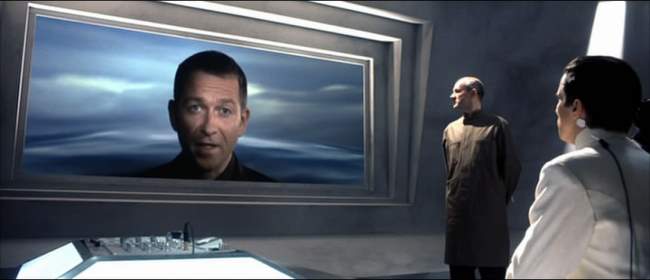
Is Equilibrium Cyberpunk? This is an open question at some level, but I’ve come down on the “yes” side (obviously, as its reviewed here) for three reasons. First, in Equilibrium, centralized control dominates all “above ground” communication, while the horizontal control is the domain of the rebels. We don’t really see any instances of an internet, but we know it exists in some form, based on the rebel leader Jürgen’s comments. The only true downer from a cyberpunk control standpoint is the book used to record contraband – gimme a break, Wimmer! The second reason is the drug, Prozium. The bio-engineered drugs serve as a dominating form of technology that serves to dehumanize society. Until we separate out “Biopunk” movies from Cyberpunk, Equilibrium belongs here. Thirdly, the visuals TRULY fit into a post-Matrix cyberpunk visual style. Without hearing a lick of dialogue, if you only saw the visuals, you might consider sticking Equilibrium into the cyberpunk bucket.
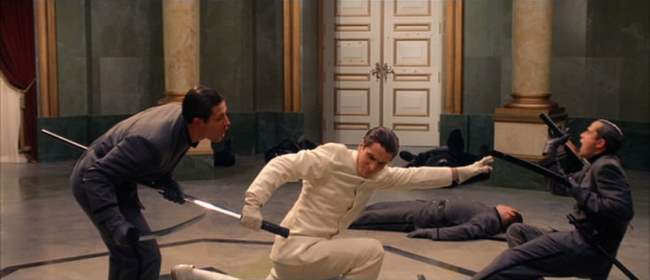
The Bottom Line: Equilibrium makes the most of its 20 million dollar budget. Truly, after watching it, most people are shocked to find out how little was spent on making Equilibrium. From an execution standpoint, everything fits like a sleeck black glove. From the well integrated and motivating score, to the high quality acting, to the even pacing, Equilibrium works to create a very believable mood. On top of this, Equilibrium’s action is hot shit! Wimmer’s creation of GunKata - a new martial arts for close-combat gunfighting is interesting and innovative. However, the story itself is still a stretch, as is the believability of the Gunkata. In the end though, this is really a minor quibble, as the end product is intelligent enough to cause you to ponder while engaging enough to keep you entertained.
~See movies similar to this one~
Movie Review By: SFAM
Year: 2006
Directed by: Laszlo Kovacs, Andrew Hookway (Co-Director)
Written by: Laszlo Kovacs
IMDB Reference
Degree of Cyberpunk Visuals: Low
Correlation to Cyberpunk Themes: Medium
Key Cast Members:
- Sue: Sylvia C. Andreae
- Jazz: Andrew Hookway
- Marshall Pax: Bryan Patrick Stoyle
- Cash: Laszlo Kovacs
- The Nemesis: Justin Monk
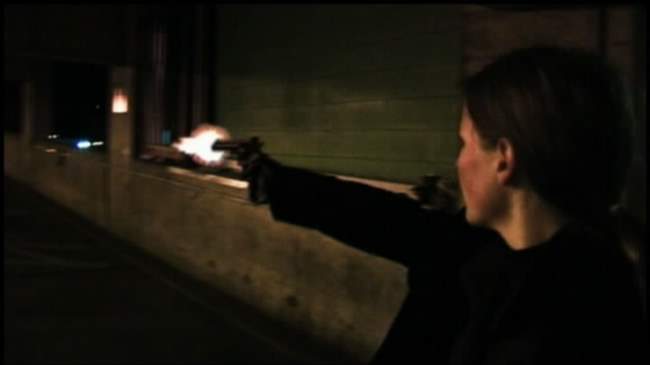
Overview: UCF: Toronto Cybercide is an attempt to create a 70s style police show done up in futuristic cyberpunk. This is a production done by an enterprising group of amateur film makers called Key Pixel: Gathering of Filmers. As a review, this is a slightly different review than many I have done previously, in that I fully realize that this movie is no-budget, and is produced by highly motivated, but amateur film makers. I had previously decided not to give it a star rating, but the more I thought about it, the more it made sense to consider it in many ways as I have the rest. This review will spend more time than most on details of what I thought really worked well, along with what I felt really needed improvement.
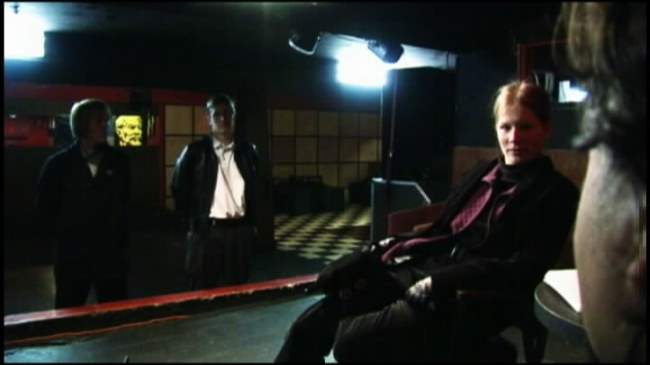
The Story UCF: Toronto Cybercide takes place over 70 years into the future. Some aspects of society have collapsed, but the police are still on the job. A team of detectives, Sue (played by Sylvia C. Andreae), a tough action chick with a cybernetic arm and Jazz (played by Andrew Hookway), an emotive family guy, are sent to investigate some strange cyber deaths, and end up getting involved in a “good cyborg gone bad” story. Here to assist with the investigation is the almost-human Marshall Pax, a cyborg from the Unified Cybernetics Foundation. Together they must root out mafia involvement and stop the Nemesis (played by Justin Monk - and what cool name for an actor!) from randomly killing Toronto’s inhabitants.
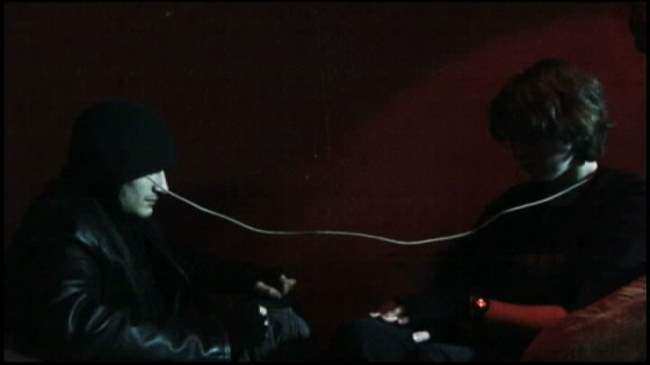
Narrative Issues: The underlying idea for Toronto Cybercide (70s cop show done in cyberpunk) is very interesting in scope, and if executed well, provides enough grist for cyberpunk enthusiasts to sink their teeth into some neat concepts. While some aspects worked well, there were a few key scenes that really could have significantly improved the overall experience.
- The Introduction: While the text was interesting, the way it was implemented made it virtually impossible to get the context. The text wasn’t sequential, and each line started at a different time. This meant that you had to almost go back and rewind for each line to complete and then try to piece it together to figure out what was happening. Even then, we miss out on why the future still has CRT monitors, current model cars, modern phones and 1940s phones together, etc. The luddites are mentioned, but really only in passing.
- Transition leading up to the final battle: The transition leading up to the final battle is virtually nonexistent. There really should have been a scene or two leading up to how and why all three parties came together. All we are given is that a trap has been sprung by the mafia, and that the police magically seem to know where.
- Why don’t we get to see the Nemesis? The bulk of the complexity in character development involves the Nemesis, but unfortunately we rarely get to see this. To the extent he shows up, we get no sense of the internal conflict taking place within the Nemesis. Toronto Cybercide really could have benefited from two scenes (one near the beginning, and one after the kitchen scene) that explored this conflict.
- Why is the Cyborg eating regular food? One of the challenges here was in trying to make the Marshall otherworldly. The kitchen scene gives a good opportunity to show him eating a fabricated food source. Instead, he is eating milk and cake.
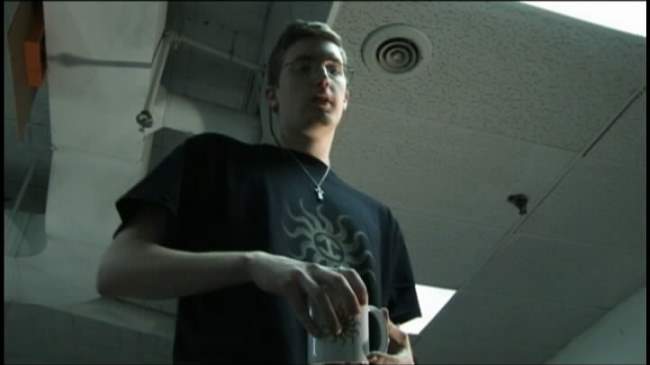
The Cinematography: Kovacs strong point seems to be in constructing some interesting visuals and textures. While many scenes were average, every now and then we’d get a terrific perspective shot, or angle which really added to the context of the scene. Toronto Cybercide is definitely at its best when going for a noir feel. Grays, blacks, overexposed whites and reds worked FAR better than the background soft yellow scenes. And while some scenes were exceptional, others, such as the dust scene sorely detract from the suspension of disbelief. Like the sound, consistency in crafting is definitely advocated.
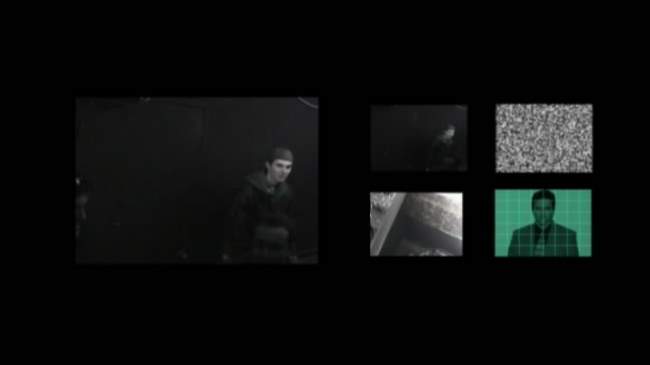
The FX: The FX is very low budget, in sort of a Dr. Who sort of way. For the most part, it works though. The laser gunshots were decent enough, and while the cybernetic arm could have been better, Andreae (Sue) worked it very effectively in the action scenes to the point that it was very believable. Perhaps the coolest one, as was pointed out on the directors commentary was the knife in the book in the Club Red scene – this just worked wonderfully and really helped sell Sue’s strength. Also terrific though was the Luddite TV screen - this more than any other FX scene left a sense of a different time and place.
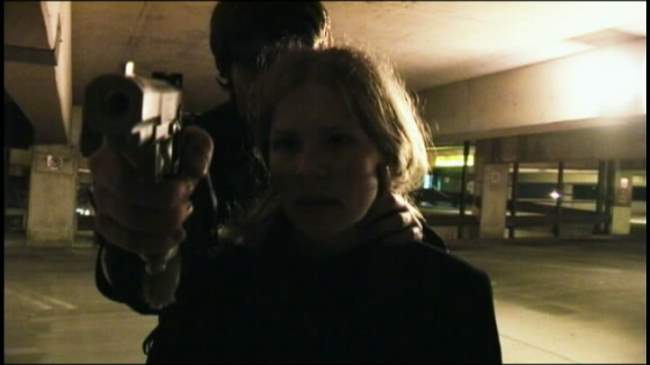
The Editing: For the most part, the visual editing in Toronto Cybercide really works. The pacing is solid, and most all of the investigation and action scenes work. In particular, the early battles and chase scenes really held together well, while the last fight scene came across as a tad too haphazard. The only early shot that really stuck out as wildly problematic was a quick camera jerk near the beginning when the long-haired minion was bitching about following “his part of the deal.” This could have been spliced a bit to become more workable.
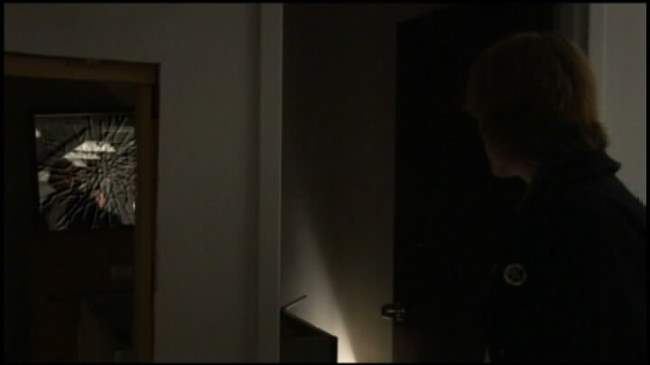
The Acting: The acting in Toronto Cybercide is far from top notch – then again, this is to be expected in an amateur production. As a clear standout, Bryan Patrick Stoyle as Marshall Pax turns in a very credible performance as a stoic, post-human cyborg. More problematic were the two cops, Sylvia Andreae and Andrew Hookway. Part of the issue is they are attempting to be your traditional 15 year, jaded cop types – this was just a hard sell both due to their age, and unfamiliarity with jaded cop stuff. From a narrative perspective, their performance would be greatly aided had it been set up that most cops had already been wiped out, and that these were junior cops thrust into events greater than they were experienced to handle. This would have played far better to their age, character development and overall performance. If there was one change I would make though, it would be eliminating Kovacs’ Matrix Merovingian nod – that scene in the Club Red CLEARLY indicates how good an actor Lambert Wilson in the Matrix sequels really is. Kovacs’ acting works well in most scenes, but that dialogue stretch will get a deservedly horrid groan from all viewers.
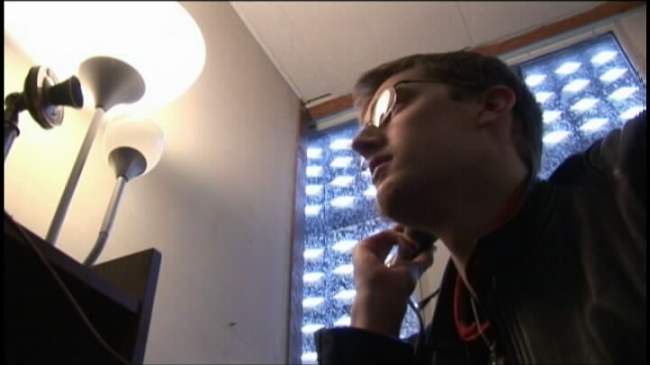
The Music: For the most part, the electronic music accompaniment is one of the best crafted aspects of Toronto Cybercide, and adds well to the mood of many scenes. Simple movement music, such as the background for the train station scene, work wonderfully to pick up the pace. The best use of sound accompaniment was probably the emotive flashbacks that Marshall Pax. The worst was definitely the ending battle. There the music was sort of a slow, ongoing, day to day sound for a scene that needed high tension, fast paced accompaniment.
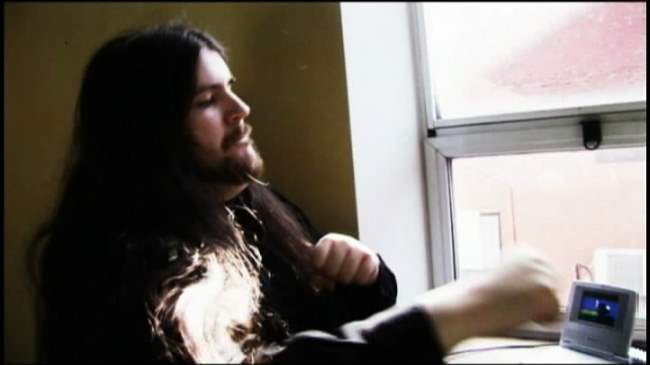
The Sound: The sound in Toronto Cybercide is sometimes great, sometimes horrid. In most scenes, we get either great background sounds or solid transfer’s of action from the left to right speakers, that carefully mimic the movement of those on-screen. These, when combined with the fast-paced electronic background accompaniment really add to the moment. In some scenes, the mix clearly needs LOTS more work – all too often the levels seem to shift dramatically, especially with the inclusion of needless white noise (the kitchen scene is probably the worst instance of this). Far worse though was a scene near the beginning - we even get an ultra-loud, high pitch sound that dominates the speakers for no particular reason – this occurs a time or two later as well. Aside from this though, clearly a lot of work to the sound FX

Best line of the movie - “Not once…did he try to grab my ass.”
Creating a Cyberpunked World Without A Budget: One of the real challenges that Kovacs and company deal with is creating a futuristic cyberpunked world on no budget. I must applaud them for making an attempt such as this, and truly hope to see more efforts such as this. Their challenge is especially problematic in that they are basically stuck with their local surroundings. Kovacs often addresses this by almost attempting to do sort of a staged play approach, where most scenes take place in barren rooms - the audience is left to fill in the details for themselves. He also attempts retrograde technology approaches, such as using 1940s phones for communications. And while some of the scenes work well, there is clearly a lot to be improved. In too many shots, we get close-ups of current year cars, lamps, and a myriad of other current-technology items that suspend disbelief. A better approach might have been to use close-up shots in cars, and so forth so as not to give away the actual “look” of the vehicle used. If they are forced to show these things, there needs to be something in the intro about describing why technology hasn’t advanced (as a counterpoint, Puzzlehead does fairly decent world-building rationales on a very low budget). In truth, the explanation on the movie cover is almost required to get the jist of the world:
In 2078 something had stopped the motor of the world.
Decades later, civilization is still recovering from the global network crash. In this post-dystopian age, remnants of the old technologies remain, including cyborgs and man-machine interfaces. To regulate the disaffected remnants - colloquially known as ‘Burnouts’ - the Unified Cybernetics Foundation is formed to deal with post-human law enforcement.
It is now 2106, one hundred years in the present. When two Toronto police detectives are caught in the middle of a specific multiple murder case involving Burnouts, UCF sends one of their Marshals to assist.
And when the Foundation gets involved, nothing is ever simple.
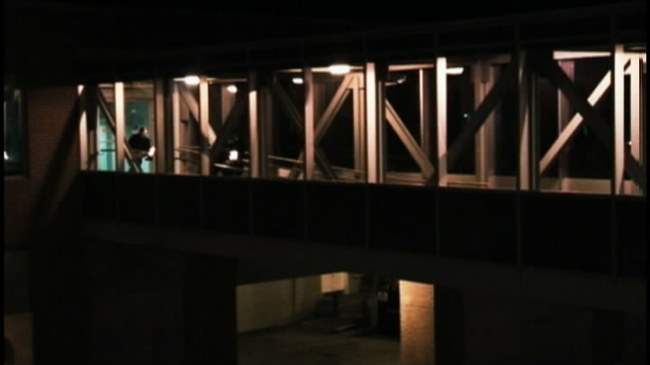
Toronto Cybercide works best in darker, shadow-filled scenes such as the shot above. A Noir look is a useful way of getting around technology shortcomings. More problematic though is the lack of exploration of the dynamics of the world itself. On Kovacs and Hookway’s commentary, they mention the concern in spending too much time on expository scenes. While I agree with the concern, this isn’t the only way the technology impacts on society can be conveyed. Character explorations and build-ins to the scenes themselves provide the grist for world building. Case in point – early in the film, our detectives do the traditional intro talk with the police chief. This would be a great scene for providing insight on how a police station might work differently in a cyberpunked world 100 years from now - instead, we get the chief typing away on a keyboard while staring at a CRT monitor. How about an earpiece, possibly an eye cover, and a VR glove where the police chief is interacting with a large flat screen? We wouldn’t even need to see the flatscreen to get a sense that things are different. If this makes no sense due to degredation in the technology, I’m sure that there could have been some way of conveying difference in surroundings here, without resorting to high-tech FX.
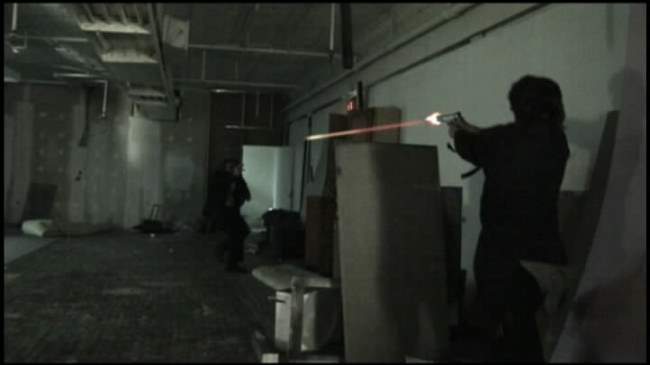
UCF Toronoto Cybercide - When Good Cyborgs Go Bad: The underlying challenge involves a specially trained marshall cyborg (the Nemesis) infected with a signal contagion. This contagion creates a complex dynamic where the Nemesis’ human portion is working hard not to allow the infection to spread, while at the same time, he is no longer in control of his actions. In an environment where we see a continual merging of man and machine, its only a matter of time before issues like this become a concern. The psychological aspect of an augmented person losing a battle over his humanity is definitely something that should require more examination. While not as explored as I much as I would have liked, the idea here is top notch, and definitely separates Toronto Cybercide from the bottom of the barrel cyberpunk flicks which don’t bother with interesting storylines.

The Bottom Line: UCF: Toronto Cybercide provides us an interesting, no-budget cyberpunk flick. I can only imagine the amount of decidation that goes in to a project such as this - in many instances this clearly shows. In some places, such as the “mood” moments, it clearly excels. Every now and then, you find a scene where everything comes together - the sound, visuals and acting have moments of riviting clarity. Some of the cinematography decisions, the pacing, the music and some fun dialogue lines serve to create a fun watching experience. Moreso, the 70s cop cyberpunk idea works. However, there are many areas where significant opportunities for improvement can be realized. If a sequel is enacted, a better explanation of the world is necessary, along with a better way of hiding current technologies. More important though would be a dramatically improved sense of consistency in the sound and visuals crafting. This more than anything else gives would move Key Pixel Productions from amateur status to that of a professional, low budget production house. Regardless, UCF: Toronto Cybercide is still a fun watch, one that I recommend you pick up. Please support this amateur cyberpunk flick and pick up a copy so that we end up with a sequel at some point.
~See movies similar to this one~
Movie Review By: SFAM
Year: 2003
Directed by: Andy & Larry Wachowski
Written by: Andy & Larry Wachowski
IMDB Reference
Degree of Cyberpunk Visuals: Very High
Correlation to Cyberpunk Themes: Very High
Key Cast Members:
Neo: Keanu Reeves
Trinity: Carrie-Anne Moss
Morpheus: Laurence Fishburne
Mr. Smith: Hugo Weaving
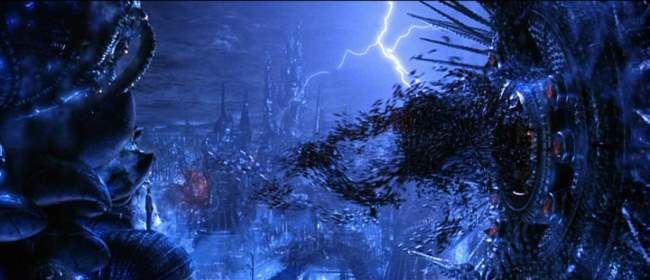
Overview: Yes, the majority of the population was disappointed with Matrix Revolutions. Many voiced issues with various movie aspects such as dialogue and acting. More still complained that the overall story was non-sensical, with many points seemly completely incoherent. Some even commented that even though it was incoherent, they absolutely loved the action sequences. Personally, I found an altogether different movie. At times I almost felt Matrix Revolutions was purposely written for someone exactly like me. My background in cybernetics seemed wonderfully tailored to understanding the trilogy from a science fiction perspective (versus the philosophical perspective that is most often explored) – as rarely do I find a symbolic struggle of positive and negative feedback systems so overtly played out in film. Strangely enough, many others tend to have this same sentiment (that the movie was MADE for them), although their backgrounds are very different from mine. In this sense, for those that LOVED Matrix Revolutions, something about the movie just “clicked” for them – in most cases, that special something was different for each person. While yes, the action is astounding, as are the visuals, its this aspect of Matrix Revolutions which is most intriguing to me. It may not be for everyone, but for those that like it, its almost tailor made.
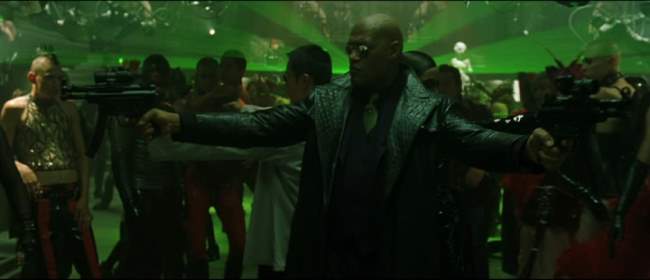
The Story: Matrix Revolutions is the third installment of the Matrix Trilogy, where Neo’s decision at the end of Reloaded causes a final confrontation between Zion and the Machines. In rejecting the Architect’s control system, Neo has thrown the relationship between humanity and the machines in a completely unpredictable direction. The machines are quickly digging to reach the last human city of Zion, while Neo, Morpheus, Trinity and a host of others look to recover from their last ditch attempt meeting with the Architect at the end of Reloaded.
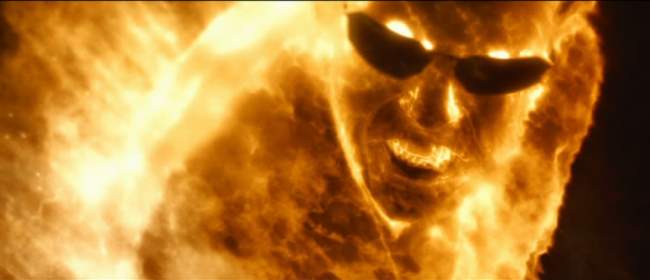
Nothing was at it seemed. The history of the one was a lie, all part of an elaborate control system. Now, in less than twenty hours, the machines will penetrate Zion’s defenses, and potentially destroy humanity forever. Worse, Neo’s mind has somehow separated from his body and now lies comatose next to Bane on-board the Ship called the Hammer. Morpheus is still despondent about the false prophecy, and the Zion’s defenses have been all but wiped out by a premature EMP pulse.
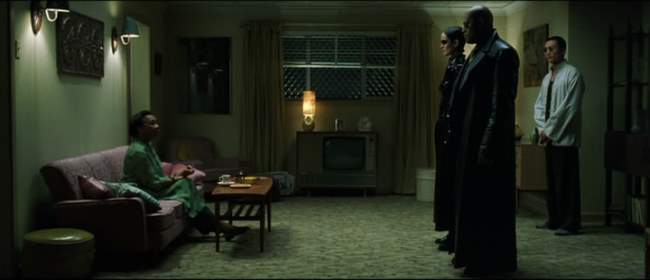
It turns out that Neo’s mind has been trapped in a place in-between the Matrix and the Machine City, inside something called the Mobile Avenue Train Station (better known as limbo, which is an anagram for “Mobile” Avenue). Unfortunately, this is controlled by the Merovingian. Trinity and Morpheus, along with Seraph must now convince the Merovingian to let Neo Free. Meanwhile, Mr. Smith has virtually taken over the Matrix with duplicates of himself while Zion prepares for the attack of the Machines, and decide to place virtually all their resources into holding the dock. As things become clear, Neo decides the only way he can save Zion is to personally go to the virtually impenetrable Machine City. Meanwhile, as the Dock Fight goes from bad to worse, Niaobi (Jada Pinkett Smith), Morpheus and company race back in the Hammer to help save Zion with the humanity’s last remaining EMP.
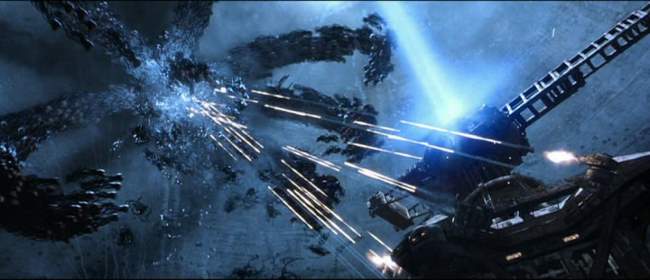
Revolutions is a War Movie: Whereas the first movie, the Matrix involved a personal awakening, and Matrix Reloaded was almost more of a chase movie, Matrix Revolutions is more a war movie than anything else. In this sense, each of the three movies are very different from one another. Many new characters are introduced in Revolutions, while some of the staples of the first two movies take more of a back seat. We see less of Morpheus here, for instance, but are almost bombarded with a myriad of secondary characters, each intended to bring us a sense of drama associated with the enormity of their undertaking. While one can discuss how well each of the minor characters worked, the need for their inclusion is rather clear – without them, the scale of the conflict doesn’t really work.

The Matrix Trilogy as a Participative Movie Watching Experience: Most movies are meant to be conveyed in a rather passive manner – one which may require the view to actively pay attention to what transpires but doesn’t require them to actively think about what they have seen. Conversely, quite a few cyberpunk flicks are just the opposite – animes like Serial Experiments Lain or Fragile Machine, extreme Japanse Cyberpunk flicks like Tetsuo, indie flicks like Puzzlehead, or even action flicks like Casshern all require the viewer to spend significant time actively thinking through the implications of what they just saw. The Matrix Trilogy, and especially Matrix Revolutions flat out requires active participation to make sense of it. Arguments abound on this point as many critics consider this a sign of bad movie making, while many Matrix fans respond with the inevitable, “You just don’t get it” comment, as if those who hate Revolutions are somehow intellectually inferior. My take on this is that this is more a sign of preference in movie tastes. Some people (like me) LOVE to encounter movies that take more than one viewing to really understand, whereas others absolutely hate watching films like this. Regardless where you come down on this, your perception of whether you like Revolutions or not will in large part be answered by your preferences on this scale.
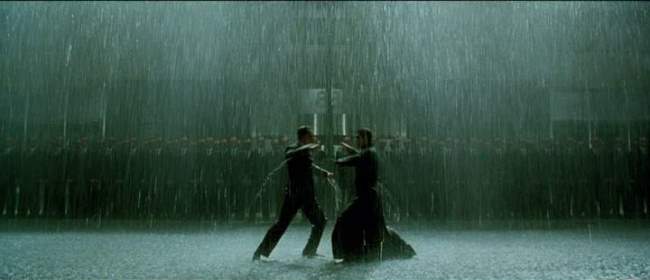
The Power of The One: The Oracle makes clear in her meeting with Neo that the “power of the one” comes from the Source, and that this power is necessary to communicate with the source. From a SciFi standpoint, the explanation for this is clear – the power of the one is based on the sentient learning program embedded in Neo from birth (the Architect tells Neo this at the end of Reloaded). As is documented in my Man-Machine-Interface essay, this is what gives Neo the power to attack the machines in the real world. Neo has Sysadmin-like powers so that he (the sentient program portion of Neo) is able to reboot the Matrix.

Getting Back to a Steady State: In Reloaded, Neo, with significant prompting from the Oracle has effectively wiped out the Architect’s negative feedback control system (meaning a cybernetic control system that “negates change from an initial goal state). The thresholds were exceeded, and the entire control system spun out of control. This, after all was the Oracle’s purpose. From a cybernetic perspective, the Oracle’s goal was to create a positive feedback loop (increasing change from an initial goal state). In doing so, she effected the complete destruction of the negative feedback system that had managed human-machine relations for the better part of 600-800 years. When a cybernetic control system exceeds its thresholds, it is possible for the system to again regain a steady-state, but almost never is it possible to return to the previous steady state. This truly is the Oracle’s purpose. By effecting out-of-control change (by creating the anomaly that is Mr. Smith), the Oracle created a situation where both the humans and machines would need to work together to stave off elimination of their species. The proposed steady state (peace) would have to be founded on a completely different set of assumptions. This would necessitate changes in the operation of the Matrix, and a far more integral relationship between the humans and machines.
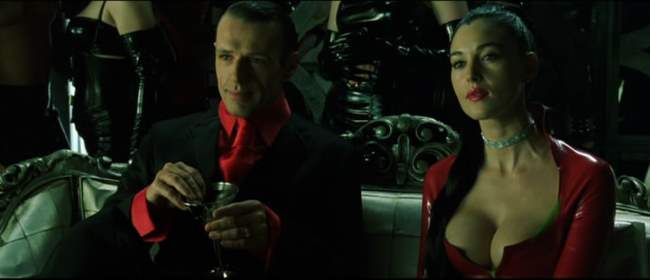
The Philosophical Aspects: Matrix Revolutions, even moreso than the previous films, is replete with interesting philosophical references from Hinduism, Christianity and various writers that ideas such as freewill and determinism, the nature of reality, the notion of purpose, and so on. In totality, the Matrix is a virtual cornucopia of ideas which ends up leading towards a larger integration of purpose, one which serves to unite the needs of man and machine in their struggle to survive. That these ideas are melded into a very compelling story – one which can almost completely divorce itself from the SciFi aspects and still work is pretty amazing. One can easily view the trilogy from the perspective of Neo as a messianic figure who’s story arc involves the coming of age, the sheding the bonds of slavery, and eventually the recapturing of humanity’s (and the machine’s) salvation. The Matrix Trilogy is one of the very few movies which have spurned an ever increasing number of philosophical analysis books – truly this is rather unique, and itself something to be celebrated.
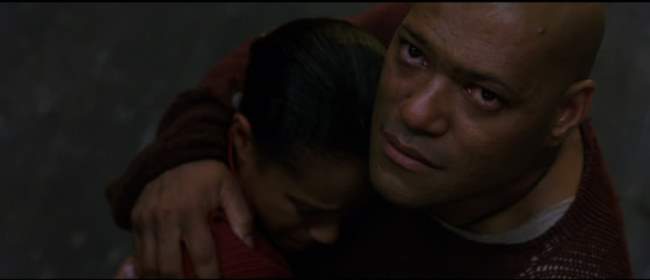
The Acting: While much has been said about some uneven performances, by and large, the leads in Matrix Revolutions turn in very solid performances. Keanu Reeves deserves additional credit for the incredible work he in preparation for the part – his martial arts and wire work in Revolutions are just terrific. Hugo Weaving turned in a supporting performance worthy of what I would consider an Oscar nomination. His monologue (“Why Neo, why?) near the end is absolutely riveting. However some of the secondary actors, most notably the “kid” (Clayton Watson) were pretty bad. Also, there were some dialogue issues in Revolutions which could have been worked a bit more (shortening the Trinity “you gave me one more chance” scene, for instance). In light of the incredibly ambitious goals for Matrix Revolutions, its not too surprising that some of the details could have been worked more.
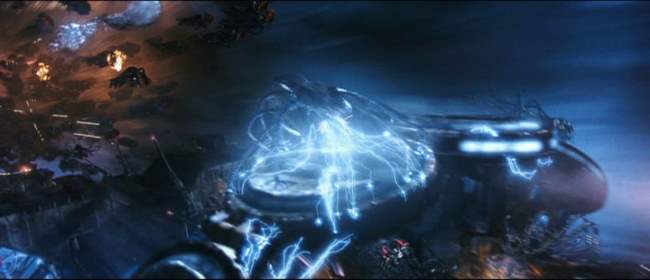
The FX: Matrix Revolutions has some of the most impressive FX on film. Regardless whether or not you hate the film, the quality and enormity of the FX we see in Revolutions is a wonderful cap to the series. From an FX standpoint, the Dock Fight was an absolutely monumental undertaking. This combination of CG, miniatures, full-sized models with human actors, and motion-capture provided one of the great battles ever seen on film. Because of the speed and chaos, like many elements in Revolutions, it really does take an extra watching or two to really get the sense of what’s happening. But once you aren’t overwhelmed by the enormity of it, the pace of the battle and the actions of the machines make sense. In fact, it becomes clear that the dock fight is one of the most significantly choreographed combat scenes ever put on film.
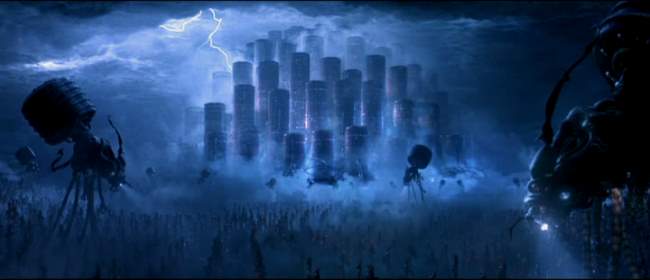
The Visuals: Visually, Matrix Revolutions is a stunning movie. While the bulk of the visuals use a blue-red color sceme, the familiar green matrix colors are also prominently displayed. Similarly, we get bursts of yellow-orange colors denoting machines disconnected from the Matrix. Shadows are liberally used in the larger panoramic scenes, while many of the close-ups are more starkly lit. Overall, the mood of the blue-red color scheme is reminiscent of Star Wars’ Empire Strikes Back, in that we get the same darkened atmosphere.
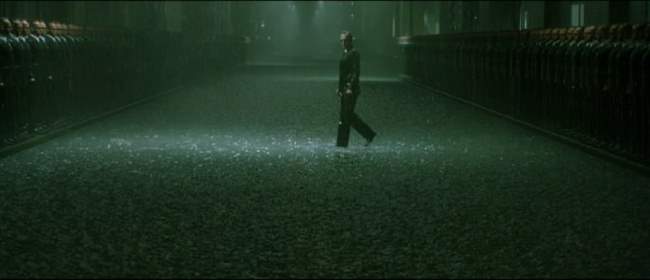
The Score: Don Davis’ music for Matrix Revolutions provided a terrific accompaniment. The diversity, from industrial sounds to haunting choral arrangements served to heighten the tension and energy at pivotal scenes. Probably the highlight of this was at the beginning of the Super Burly Brawl between Neo and Mr. Smith where the piece, “Neodammerung” signals the final confrontation.
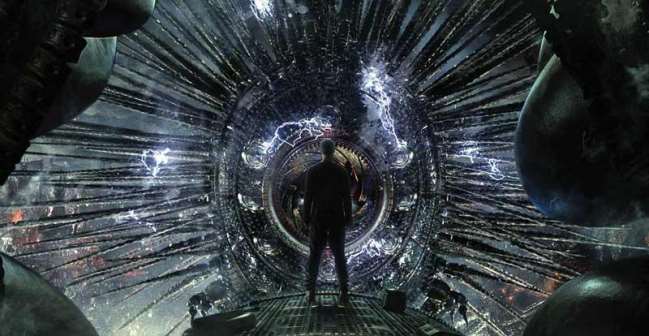
The Bottom Line: The Matrix Trilogy is one of the most ambitious projects ever undertaken in movies. It combines almost two distinct storylines – one based on philosophy and religion and the other based on science fiction – with revolutionary effects, great action and truly interesting ideas throughout. As a cyberpunk dystopia, it’s hard to find a situation worse than the one posed in the world of the Matrix. While the majority of its viewers found fault with Revolutions, especially the ending, I personally found enormous satisfaction out of both the ending and the movie as a whole. While I certainly agree that there are some acting and dialogue issues, as a whole, Revolutions was a terrific ending an absolutely terrific trilogy.
Matrix Revolutions Page 2: More Screencaps –>>
~See movies similar to this one~
Movie Review By: SFAM
Year: 2006
Directed by: Richard Linklater
Written by: Philip K. Dick (Novel) Richard Linklater (Screenplay)
IMDB Reference
Degree of Cyberpunk Visuals: Medium
Correlation to Cyberpunk Themes: Medium
Key Cast Members:
Bob Arctor: Keanu Reeves
James Barris: Robert Downey Jr.
Donna Hawthorne: Winona Ryder
Ernie Luckman: Woody Harrelson
Charles Freck: Rory Cochrane
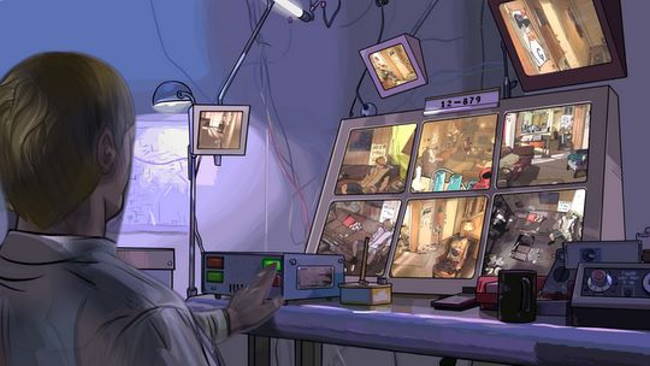
Overview: In a very faithful adaptation to Philip K. Dick’s story of the same name, Linklater treats us to an interesting, slow moving story about abuse – abuse of power, drug abuse, abuse fo friendships, and abuse of the self. While most of the publicity about Scanner Darkly is about the rotoscoping technique used, the story itself is good enough that it probably could have worked in live action as well. A Scanner Darkly is engaged in a slow-opening process – hopefully you all get to see soon in a theater near you.
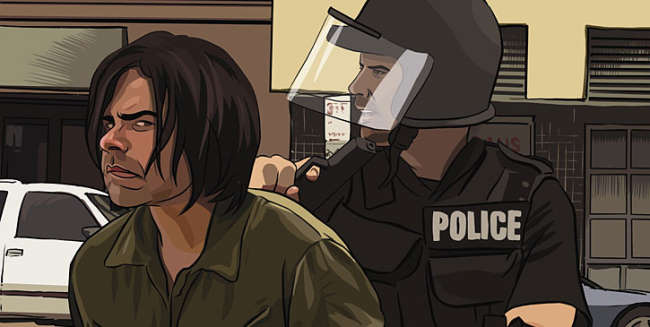
The Setting: Seven years into the future, a drug known as Substance “D” has transformed society. People are divided into addicts and those who haven’t taken Substance “D.” Society is quickly collapsing. In response to this threat, the government has transformed the society into a surveillance state, where neighbors spy on neighbors, and personal freedoms have been minimized. Everything is organized for instant observation – license plates are now bar-coded, and security is all DNA based. Trust has all but vanished in the world where Scanner Darkly resides. In its place, we have people who are constantly concerned about each other’s ulterior motives, and think nothing of stabbing someone in the back if only to win short term gains.
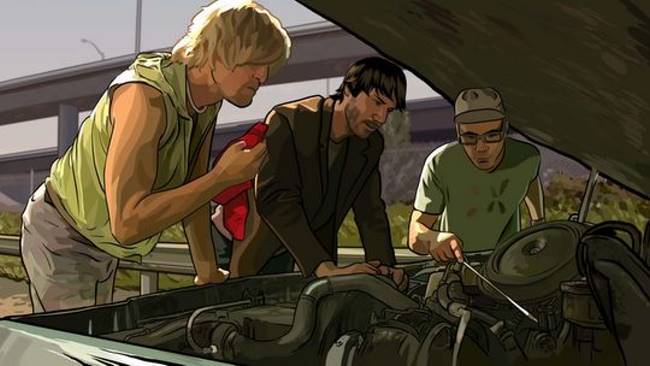
The Story: Scanner Darkly takes place seven years into the future and follows the plight of a close-knit group of addicts living outside of Anaheim, California. Bob Arctor (Keanu Reeves) is works as a reluctant undercover police officer (called “Officer Fred” at work), who lives with group of addicts that he eventually needs to perform surveillance on. Bob no longer believes in what he is doing, but still goes through the motions. At work, all the police wear “scrambler suits” to ensure nobody knows who they are. As the story progresses, we get to see the absurd lives that each of the addicts lead. Bob’s girlfriend (Winona Ryder) is a coke addict who freaks out if touched; his friend Charles (Rory Cochrane) sees insects crawling over him at all times, and his two room mates are clearly fried beyond all recognition.
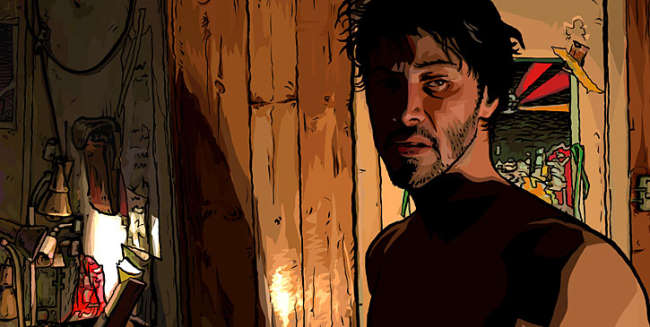
Unfortunately for Bob, his addiction is growing too. His grasp on reality starts to weaken as the hallucinations increase. He starts seeing his room mates as huge insects. Worse, one of his room mates (Robert Downey Jr.) visits the police department to narc on Bob. Bob, as the disguised Officer Fred, has the task of taking down his room mate’s statements and investigating them. As the movie proceeds, Bob becomes more disillusioned with his job and life, and begins to realize that he is losing his humanity.
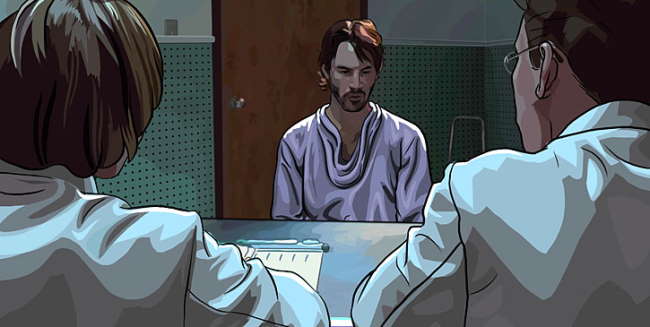
An Excersize in Duality: Scanner Darkly sets a number of issues up in a duality. We have left brain – right brain separation as a side effect from extreme exposure to Substance “D,” we get surveillance and security opposing personal freedoms, and the two doctors treating Bob overtly represent the left and right hemispheres. Everything in Scanner Darkly is about dualities of tension, and the descent of humanity in the face of this tension.
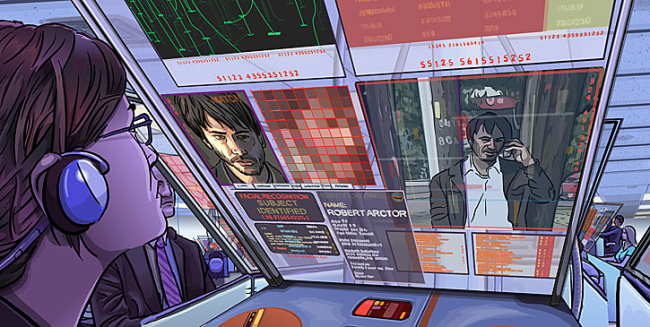
The Paranoia: A Scanner Darkly delves into the paranoia mindset that develops when drug use combined with an out of control surveillance society has taken hold. Personal rights and individual freedoms are significantly subordinated in a society where the government is after the supposed drug barons. One begins to question, however, whether the drug barons themselves are just yet another tool by the government to gain complete control over the population. The idea of government abuse of power permeates virtually every scene. The ranting sessions within the drug addict group are all based on paranoid delusions about what the government is currently doing to them. Worse, some of their “paranoid delusions” end up being true!

Drugs Are Bad, K? Scanner Darkly pounds this message in as many ways as possible. Wanna screw up your perception? Substance “D” is for you! But don’t worry, its effects are not always permanent, just most of the time! Within the addict group, we see different people in various states of insanity. The message is clear – once you’re on this stuff, the descent into insanity is all but assured.
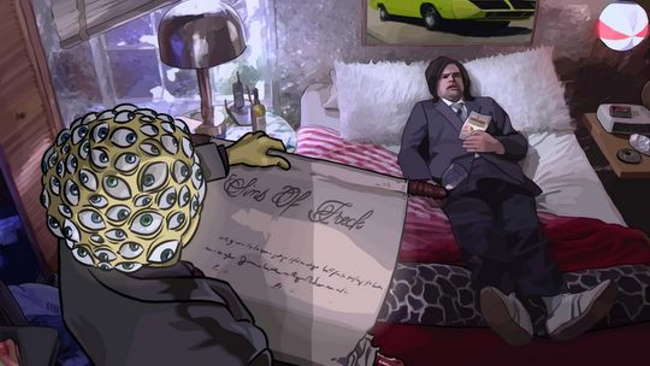
The Rotoscoping: The rotoscoping in Scanner Darkly works well as a device to create an atmospheric, otherworldly film, even though most of the scenes almost came off as red-neck central. Unlike Waking Life, where the hand drawn animation on top of live action is wildly uneven (on purpose) with the characters, for the most part the rotoscoping just gives it an ambiance. Also, the rotoscoping provides a wonderful base for the various hallucinations that happen in the course of the movie. Linklater’s rotoscoping technique seems to work best when there isn’t that much action on-screen. In some of the movement scenes (car riding, running, etc.), there is almost no difference between the rotoscoping and live action. There was also a lot of variances with the black lines around the faces – mostly this was pretty subdued, but in a few scenes, the black lines almost dominated the scene.
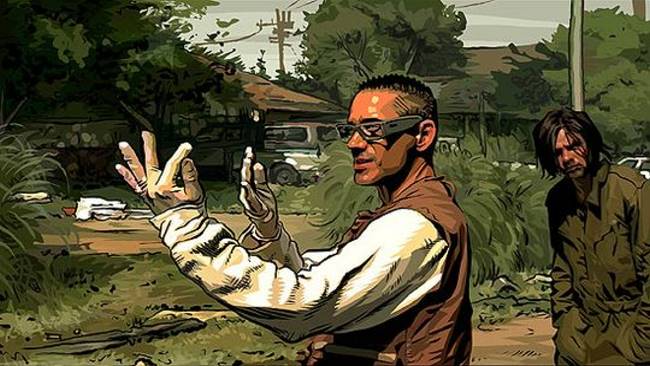
The Acting: For the most part, the acting is terrific in Scanner Darkly. Robert Downey Jr. especially shines, but Reeves’ performance fits perfectly for a man overtaken by events. Winona Ryder has some pretty solid moments (especially at the end), as does Woody Harrelson and Rory Cochrane. The better scenes usually involve Downey and another character involved in truly bizarre conversations. Some with Downey and Harrelson in particular are pretty funny.
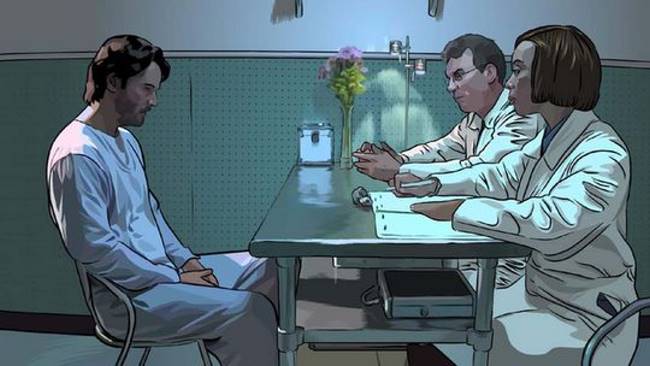
The Bottom Line: A Scanner Darkly is a movie with great acting, interesting discussions and a very powerful ending. That said, some parts of Scanner Darkly come off as overkill (the drugs are bad part, for instance), whereas others could easily have benefited from more elaboration. Still, these are minor complaints, as the overall movie has terrific acting, a great score (by Radiohead), and an interesting, well constructed message. Fair warning though - this is NOT an action movie. The vast bulk involves people milling around and talking, without any real action ever taking place. As long as action isn’t necessary for you to enjoy a good cyberpunk flick, give Scanner Darkly a try.
~See movies similar to this one~
Movie Review By: SFAM
Year: 2002
Directed by: Kenji Kamiyama
Written by: Masamune Shirow (Story), Kenji Kamiyama (Chief Writer), et al.
IMDB Reference
Degree of Cyberpunk Visuals: High
Correlation to Cyberpunk Themes: Very High
Key Cast Members:
- Major Motoko Kusanagi: Atsuko Tanaka (Japanese), Mary McGlynn (English)
- Batou: Akio Otsuka (Japanese), Richard Epcar (English)
- Chief Daisuke Aramaki: Osamu Saka (Japanese), William Knight (English)
- Ishikawa: Yutaka Nakano (Japanese), Michael McCarty (English)
Rating: 9 out of 10
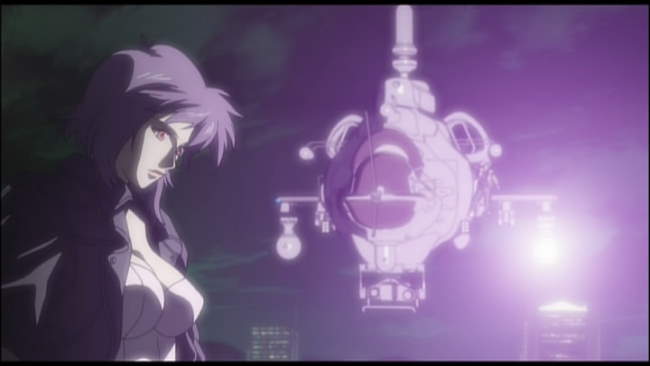
Overview: Ghost in the Shell Stand Alone Complex (GITS SAC) uses the same characters as Masume Shirow and Mamoru Oshii, but takes place prior to the first GITS movie. Like the GITS movies, GITS SAC revolves around Section 9, an elite anti-terror police force that works behind the scenes to keep the peace. The overall tenor of this series is far more action oriented than Oshii’s movies. While there are a few philosophy moments (including a terrific one with Batou and the Tachikomas), the vast majority of the season is action oriented. In short, we get high-end, slick cyberpunk butt-kicking in GITS SAC – one that’s well worth watching, even if you do miss the philosophy.
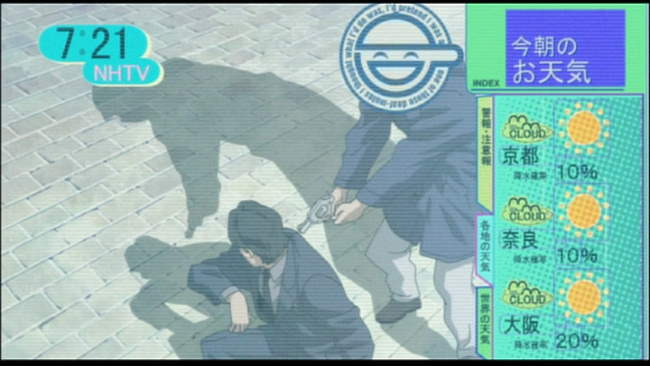
The Laughing Man Story: In a world where cyberization has become the norm for a large segment of the population, a number of negative side effects have become possible. In addition to cyberbrain hacking, a disease called Cyberbrain Sclerosis has emerged which seems to randomly affect many who’ve undergone significant cyberization. The Mega-corporation, Serano Genomics has produced a cure for Cyberbrain Sclerosis – Serano Micromachines, a nanotech implant device that, when ingested regularly supposedly halts and eventually works to cure the disease. Unfortunately, the Micromachines only seem to help a small segment of those contracting the disease. A hacker named the Laughing Man seems bent on exposing a cover-up – one which posits that the lost Murai Vaccine has an almost permanent curative for those with Cyberbrain Sclerosis. Unfortunately for Serano Genomics, a real cure for Cyberbrain Sclerosis would decimate their profitability.
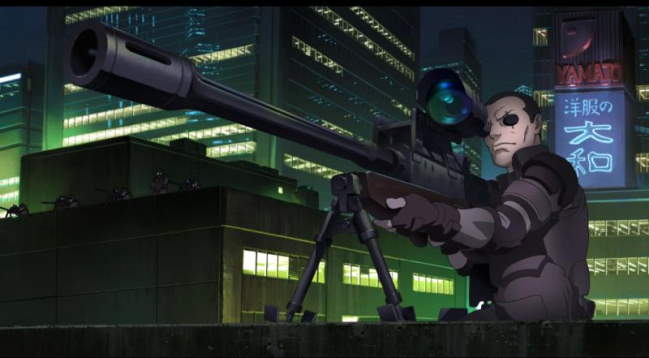
The Laughing Man is a hacker extraordinaire who is able to hack into cyberbrains at will, and worse for public confidence, is able to take over TV shows at will. Section 9 has been brought in to find and stop the terrorist known as the Laughing Man. Throughout the season, while there are side plots, it’s the Laughing Man story which drives Section 9. As it continues, the intrigue builds and the plot thickens. Eventually, corporate betrayal, political scandals and personal vendettas play a role in setting the context and exposing the larger truth.
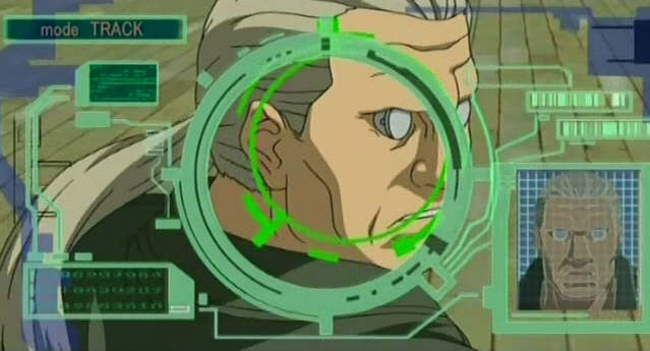
The Side Stories: While the Laughing Man is the focus of the season, there are many side quests in GITS SAC. Some of the episodes closely resemble stories from Masume Shirow’s original GITS Graphic Novel. Among these, Batou has an interesting commando encounter with his past, and Aramaki is taken prisoner by thieves in a bank, only to get involved in a more intriguing plot. For him to survive, Motoko must be able to interpret his actions from afar to correctly figure out his strategy. Generally, the stand-alone episodes are good enough to keep you entertained – some are excellent.
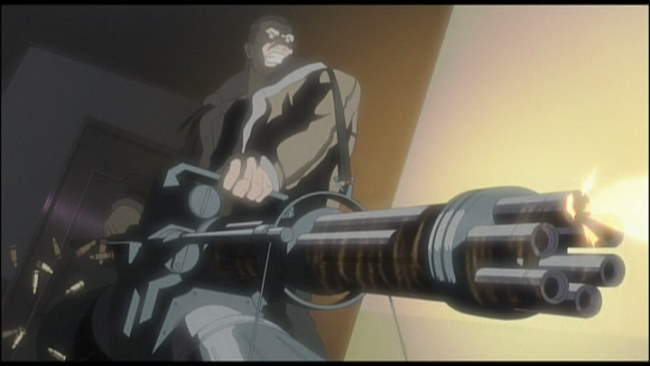
7Th Volume is the Best: While GITS SAC is pretty good throughout the series, the 7th volume – the last one – is by far the best. Without the 7th volume, I would probably rate GITS SAC 8 stars, but the 7th volume really deserves a 10 star rating. In the 7th volume, Section 9 is disbanded, while political intrigue hounds their very lives. The team escapes a crack commando unit and then all go their separate ways. Motoko and Batou become the focus of the volume, and in doing so, display more humanity and feeling then they do the rest of the series. On top of this, many of the best FX are found in volume 7.
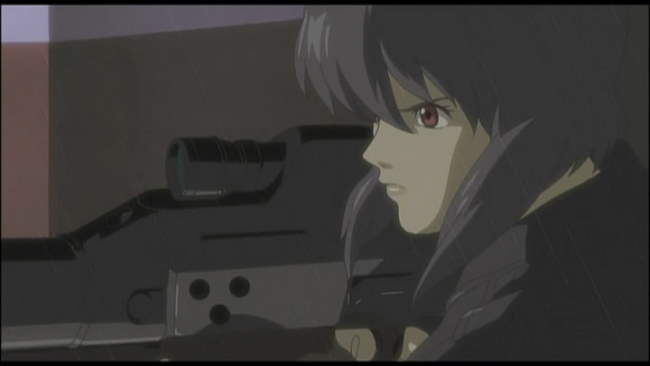
Differences with Oshii and Similarities with Shirow: Whereas Mamoru Oshii’s movies centered on the impacts of a cyberpunked society to the individual (Motoko in GITS, and Batou in GITS: Innocence), GITS SAC tends to broaden the filter to look at overall patterns in society. This leads to wonderful throw-away gems like the virtual meeting room (basically a holodeck) where everyone jacks into the meeting and then disappears when complete. We also get plots centering on problems with children in this changed new society, alienation of the masses, and loss of identity and humanity as technology takes center stage in human interaction. GITS SAC is also far more like Masume Shirow’s original graphic novel. While it doesn’t have the overt sexuality of Shirow’s work, Motoko is drawn as Shirow would; Shirow’s humor is evident in a number of the episodes; and the action takes center stage for the most part.
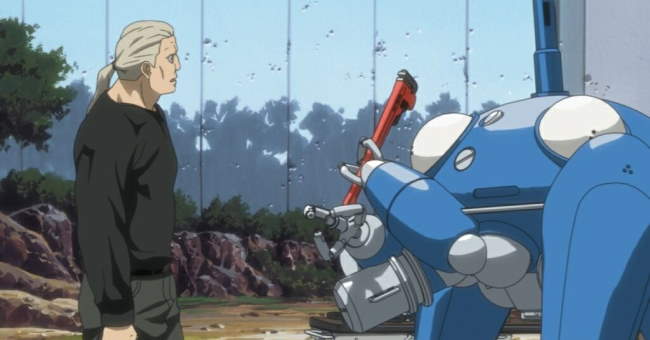
The Tachikomas: Early on, Major Motoko Kusanagi determined that the Tachikomas weren’t destined to be front-line fighting droids. For this reason, in order to become useful, the Tachikomas sped up their learning AI processing. As the season progresses, the Tachikomas begin to exhibit full signs of sentience, including Freewill and more devious functioning – so much so that Motoko becomes worried about their potential. Many interesting discussions take place over the development of the Tachikomas. One of the more intriguing ones that wasn’t really answered was whether being a digital life form instead of an analog one, would the Tachikomas ever develop a Ghost?
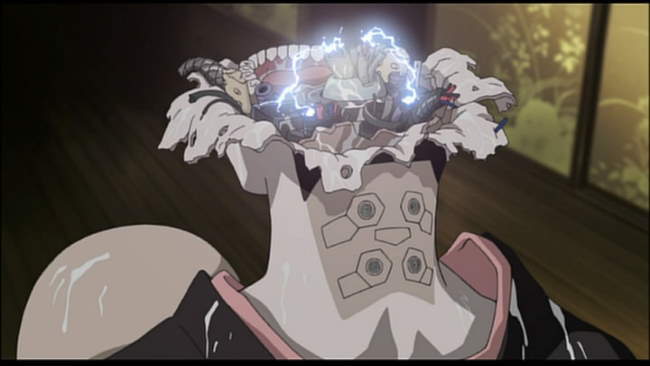
External Memory Devices and Cyberbrains – Augmented Thinking: One of the really interesting things about the GITS world is the integration of augmented brains. Conversations and complex thinking become dramatically enhanced. While the philosophical conversations are significantly reduced in GITS SAC when compared to the GITS movies, we still get a myriad of instances where cyberbrains allow people to call up a set of details about any subject that no other human could ever do. Cyberbrains in GITS SAC show a society where humanity truly has become post-human in a very real way, even though the actual look of most humans hasn’t changed much.

The Dubbing: GITS SAC is one of the few animes where the English cast is just about as good as the Japanese cast. Both William Knight (Aramaki) and Richard Epcar have been in their roles from the initial Ghost in the Shell movie in 1995, and all of the cast members have stayed consisted for both GITS Innocence and GITS SAC. Atsuko Tanaka (Motoko), Akio Ôtsuka (Batou), and Kôichi Yamadera (Togusa) have also been in their roles since 1995. It’s hard to pass up on Atsuko Tanaka though – I love her as Motoko. In any event, while the moods between the English and Japanese cast are different, they are both excellent.
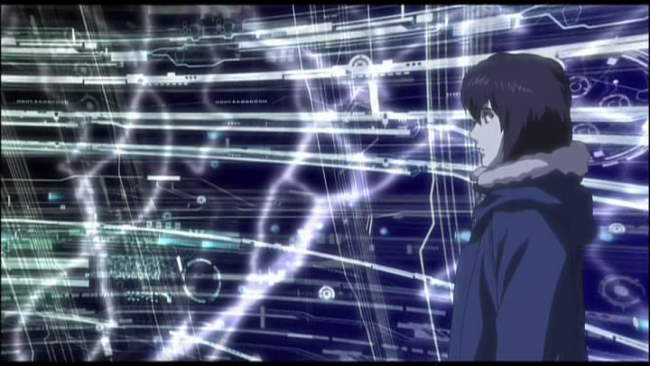
The Sound: GITS SAC consistently has decent quality sound supporting the visuals. The use of the side speakers for voices is especially emphasized. The sound FX (explosions, gun shots, car chases) are always top notch. But truly, the most impressive thing in terms of sound is the sound track. The opening and closing songs (Inner Universe and Lithium Flower) by Yoko Kanno are flat out terrific. Throughout, we are treated to a variety of songs and background music, which almost always add to the action and visuals on screen.
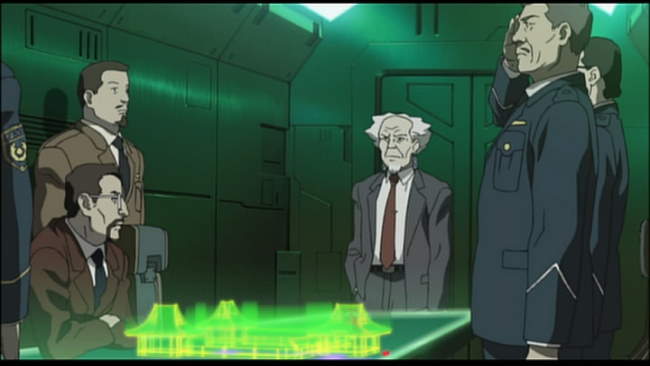
The Visuals: GITS SAC has a variety of aids that add to the overall quality of the look. While some shots look pretty basic, others involve a variety of cool FX, including digital color grading, a myriad of environmental effects, and cell-shaded computer models. GITS SAC gives us a variety of color palettes including dominant greens, reds and blacks, and occasional blues and yellows. Overall, GITS SAC is a very professional, high quality production.

The Bottom Line: GITS SAC is a high quality cyberpunk production. While I personally like the tone and tenor of Oshii’s movies far more than I do GITS SAC, this is a personal preference. GITS SAC provides continued quality action wrapped up in impressive visuals and sound. While the first 6 volumes might only merit an 8 star rating, the conclusion is just terrific. This, along with the overall high level crafting GITS SAC provides throughout (visuals, sound, dubbing, songs) certainly raises the bar. And do yourself a favor – watch GITS SAC on a system with high quality surround sound – you’ll notice the difference.
Movie Review By: SFAM
Year: 2005
Directed by: Ben Steele
Written by: Darren Dugan, John Pinckney, & Ben Steele
IMDB Reference
Degree of Cyberpunk Visuals: Very High
Correlation to Cyberpunk Themes: Very High
Key Cast Members:
Leda Nea: Xi
Goho, Mary Nea: Molly Pinckney
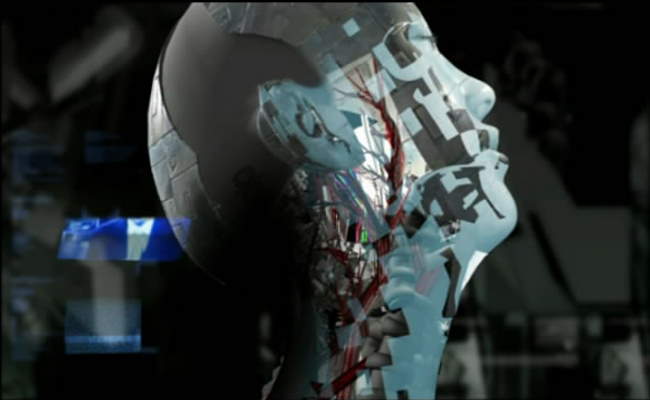
Fragile Machine - a Cyberpunk Operetta: If there was ever such a thing as a cyberpunk operetta, Fragile Machine is it. Fragile Machine is an indie anime film short created by a very small organization of talented artists called Aoineko. Fragile Machine’s narrative is largely told through haunting Chinese and English vocals set to a rhythmic, keyboard-laden techno beat (you can hear the main track by clicking on the aoineko link above). The combination of mind-expanding surreal android images with Aoineko’s music provides an intensely immersive experience – one which slowly envelopes your senses until you are a participant on Leda Nea’s journey. Fragile Machine is divided into six distinct chapters, and is narrated by a small android girl named Goho.
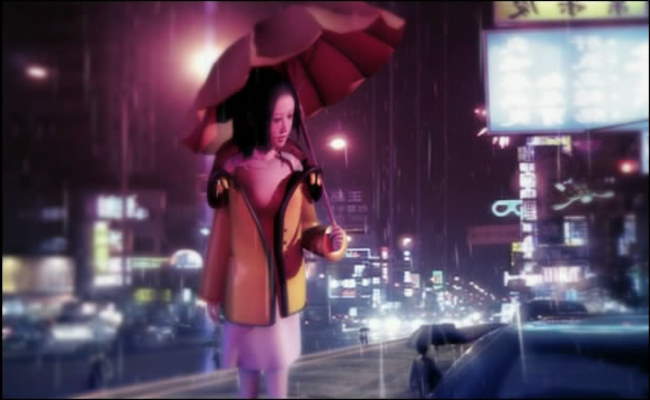
The Story: Leda Nea, a lead scientist heading up android firm, Göln Remedios’ Project Zero, is distraught over the death of her daughter, Mary. She no longer is interested in living, and decides to sign away her rights to be become a test subject for Project Zero. Leda Nea agrees to have her consciousness inserted into an android body, but the experiment goes horribly wrong, and Nea’s consciousness is permanently trapped in the android. A year goes by and Leda Nea becomes Göln Remedios’ primary work. Leda Nea has lost all sense of her former life, but still realizes she is trapped in a antiseptic prison – one which she desperately wants to escape.
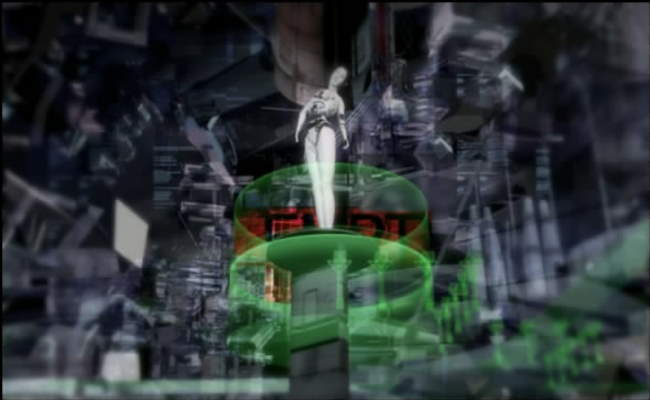
Eventually Leda Nea finds a way to trick her captors by using some of the android shells as decoys. Allthough still pursued by Göln Remedios’ droids, she escapes to the woods, and, surrounded by nature, begins to remember her humanity. In doing so, Leda Nea remembers that she hates herself and her very existence, and finally begins to remember the daughter she has lost. She continues to be pursued by Göln Remedios’ drones, but instead of getting captured she throws herself into a lake, and thus destroys her android body. At this point, her soul frees itself from its android host and embarks on an entirely new journey – one which could potentially provide Leda Nea salvation by connecting her back with that which she lost. While the ending chapter is visually astounding, I can’t go further without giving away the rest of the story.

A Post-modern Narrative: One one level, Fragile Machine appears to be a straightforward narrative in that it is explicitly divided into six chapters. Yet in watching this film, it becomes clear that the narrative is anything but straightforward. To understand the story, the viewer must pay close attention to the symbols, lyrics Goho’s commentaries, and the various visual indicators sprinkled throughout the film. While lasting just over 30 minutes, those interested in understanding the message will definitely benefit from giving Fragile Machine multiple viewings. The third time through, I found myself freezing the screen on a number of images in order to understand their significance. The story summary above is the result of watching Fragile Machine a number of times prior to piecing this all together. For instance, only very late in the film do you find out that Leda Nea is project manager of Project Zero, and is thus, responsible for her own destruction.
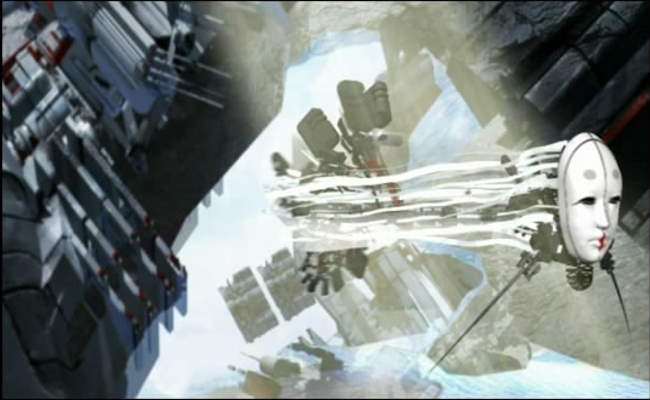
The Visuals: Even if you don’t care to spend time understanding the rich story and symbolism, Fragile Machine’s android visuals alone are well worth the cost of the DVD. Fragile Machine comes at man-machine integration and android creation and destruction from such a myriad of directions that it leaves the viewer in a state of wonderment. Through the film, color palettes are linked with the various symbols portrayed in Fragile Machine. Visual Homages are paid to a myriad of sources including Blade Runner, Metropolis, Ghost in the Shell and Planet of the Apes.
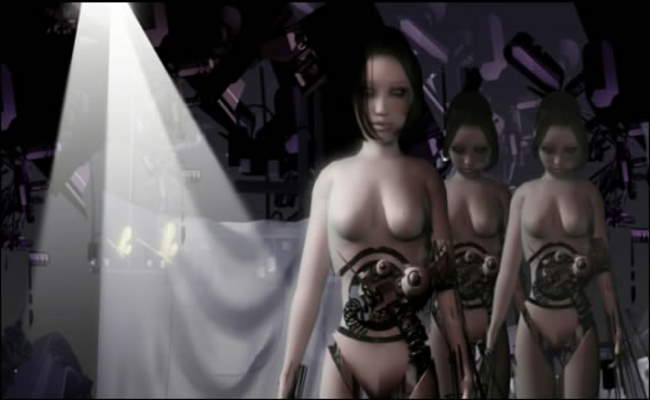
Animation Issues: While the artwork in Fragile Machine is intensely creative, the CG movement is definitely subpar when compared to some of the larger budget works. When Leda Nea is running, or the puppet narrator, Goho, is talking, the quality of the animation negatively affects the immersion. Depending on how you come to see Fragile Machine, this might be enough to turn you away from this incredible picture (perhaps this accounts for the insanely low score on IMDB). However, I would argue that the animation is only a minor knock in an otherwise perfect film short. In looking at the immensely small crew involved in making Fragile Machine, they pretty much nailed all aspects of this film that didn’t require massive CG animation engines. The post-modern story, the artwork and the music are all par excellence.
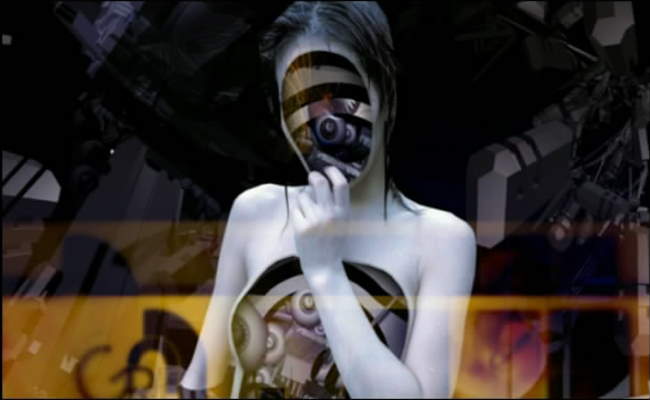
Interpreting Fragile Machine: Fragile Machine is visually and symbolically rich enough that the viewer can extract a number of fascinating thoughts. However, the larger point that Fragile Machine traces is a common cyberpunk theme - the idea that humans, in its pursuit of technology believes they will become omnipotent, with power over life and death itself. Yet in pursuing this course, we end up losing that which defines us – our humanity. Eventually, this pursuit of the taboo ends up destroying our very society. In a wonderful review of Fragile Machine, Jens points out that the corporation developing the androids, Göln Remedios, is visually similar to the Tower of Babel – both are stretching to the heavens in order to become God’s equal.
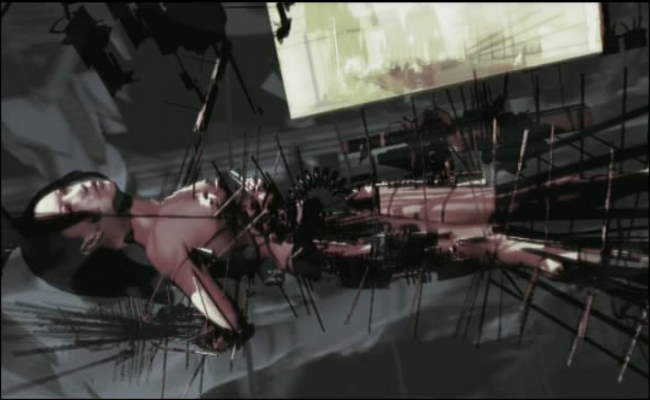
When we find out that Leda Nea is in fact the Lead for Project Zero, the emphathy shifts from a rather simplistic view Göln Remedios’ evil CEO figure being responsible to a far richer view. Leda Nea, in losing her daughter has lost her humanity, and thus no longer feels compelled to remain “human.” Her decent into subverting humanity starts well before she is captured in an android body. It begins with her work to build project zero – a project which at it core attempts to extract humanity and incarcerate it within a machine host. One almost wonders if Leda Nea initiated Project Zero in response to her daughter’s death. While the evil CEO is clearly interested in using Leda Nea as a tool in attaining virtual Godhood, it is Leda Nea who chooses to become the virtual fallen angel (as depicted by her red hue much of the time during her android descent). But ultimately, Fragile Machine becomes a story of redemption, as Leda Nea’s lost daughter, as represented by the elephant doll, becomes her guide towards finding ultimate salvation.
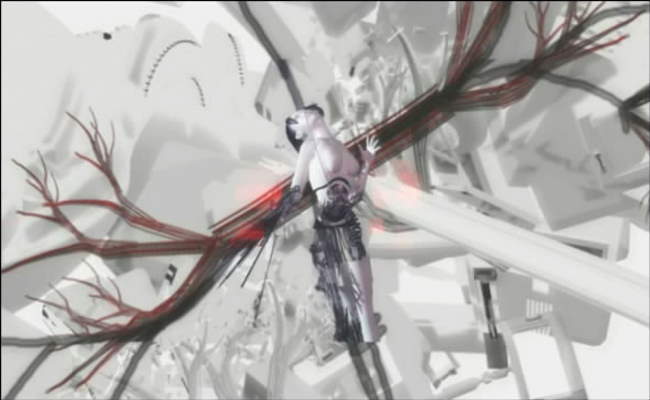
If an Android had a soul, what would happen to it when it dies? One of the more interesting questions Fragile Machine raises is the idea that if an android had a soul, what would happen when it dies? In pursuing this thought, Fragile Machine operates in the same territory as Ghost in the Shell, in which a human soul is essentially trapped within an android body. But the thought it raises can easily be taken farther than this: as we move ever closer towards sentient machines, what exactly becomes the difference between machines and humans? If machines become sentient, could they not also develop a soul? And if so, can this soul exist in some fashion even after its host has died?
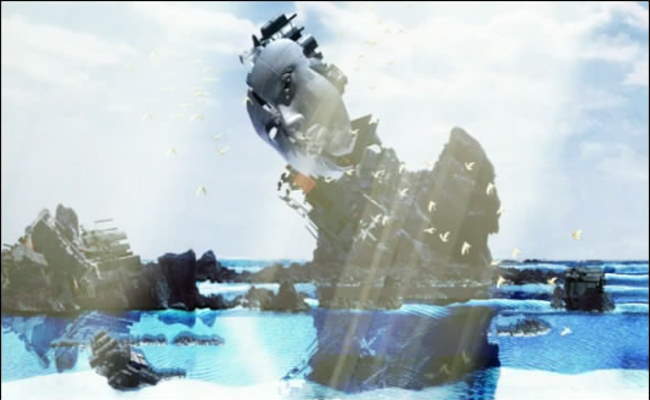
What Does a Human Mask Represent? Similar to f8, Fragile Machine uses a mask of a human-looking face to represent the attainment of humanity. Only in this case, the mask represents humanity’s technology enabled drive to create post-humanity – androids in our own image. Interestingly, this interpretation masks when viewing the last chapter of Fragile Machine leads to an interesting conclusion about the pursuit of post-humans. One wonders whether it is possible to pursue sentient androids in a way that does not explicitly challenge God’s (or nature’s) sacred role over life and death. Fragile Machine almost seems to be advocating an evolutionary, emergent approach over an overt, dominating, dehumanizing approach.
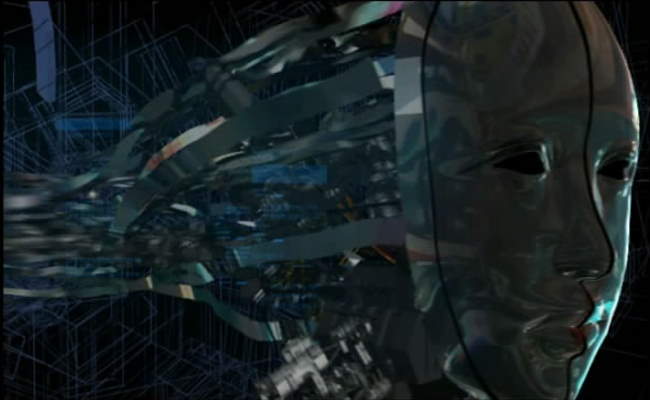
The Bottom Line: Rarely do we encounter a film so creative in its development, where the sounds and visuals are inexorably linked in expressing such an interesting story. While the animation isn’t on par with larger scale productions, the songs and visuals more than make up for it. In totality, Fragile Machine conveys a complex, multi-layered story that is rich in symbols and ideas. This is truly a piece of cyberpunk art not to be missed. The DVD was out of print but is available again (see in the comments section for details). Give it a try if you’re looking for something different.
Spoiler Alert! Page 2 has more screencaps, but some relate to the ending –>>
~See movies similar to this one~
Movie Review By: SFAM
Year: 2000
Directed by: Allan Moyle
Written by: Christopher Pelham
IMDB Reference
Degree of Cyberpunk Visuals: Low
Correlation to Cyberpunk Themes: Medium
Key Cast Members:
Clone #1/Toffler 3: Stephen Baldwin
Toffler/Fisk 2: Kim Coates
Fisk/Toffler 2: Kyle MacLachlan
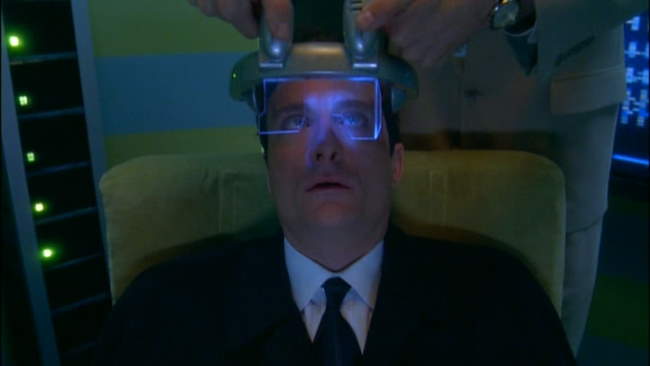
Overview: Xchange is one of those movies that comes up with an interesting if unbelievable Sci-Fi premise (mind transference technology) and then proceeds to hose it beyond all recognition with a horrid script, bad acting and flat out bizarre (not in a good way) scenes. Still the initial idea about exchanging conscious minds is interesting enough to at least keep you watching for the first 20 minutes or so. Whether you care to after that is truly a matter of how much you like trashy cyberpunked Sci-Fi.
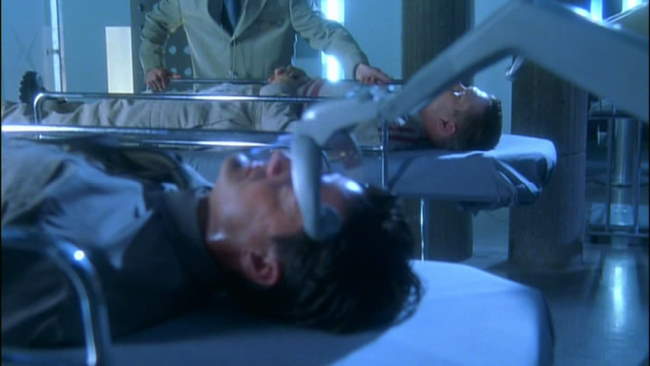
The Setting: In the near future, the technology can enable a person’s consciousness to be exchanged with another. So while you may take on the speech patterns of the new “host,” your thoughts and memories are still “yours.” Furthering this technology, a company, Xchange, now uses this technology to enable instant travel across the globe. You just need to go into an Xchange office, agree upon a temporary host (male or female), and plug-in. But wait, there’s more! In addition to Xchanges with humans, the Xchange corporation has also created disposable clones with supra-human abilities that are ready-made to accept a temporary mind transferal. Unfortunately, the clones only last a few days before self-destructing (one might wonder how the development of a full human clone that only lasts two days could possibly be cost-effective, but, um, this isn’t really explored). Unfortunately for society, the near-future has turned onto a world of the haves and have-nots, where corporations sit on top of a society where life is only valued if you are a corporate stooge.
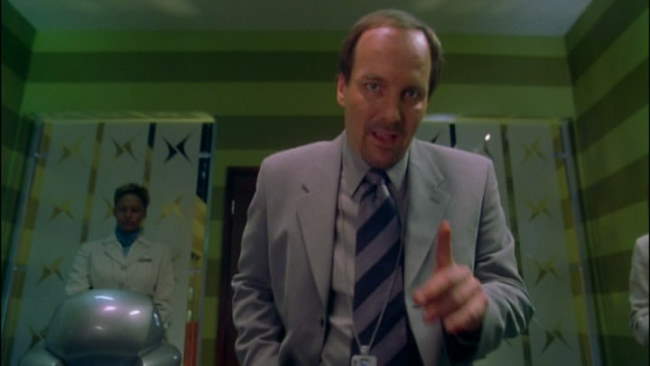
The Story: Toffler (Kim Coates) is a corporate executive who has it all. His one fear is that he’s afraid of undergoing mind transferal travel, or “floating” as it has become called. Unfortunately for him, his biggest corporate customer’s CEO has been murdered and the CEO’s son needs him by his side in an hour for an important meeting on the other side of the country. Due to the time issue, Toffler is forced to undergo his first floating instance. A temporary host has been found at the last minute, so everything seems to be set. While the transferal and meeting goes off without a hitch, and in fact Toffler (now Kyle MacLachlan) has found the experience to be enjoyable, problems arise when Toffler goes back the next day to transfer into his own body. Unfortunately, the temporary host that now is traveling in Toffer’s body has not returned – worse, his current body appears to be stolen, and the Xchange corporation is asking for it to be returned. In fact, it appears that the most notorious terrorist now is in control of his body.
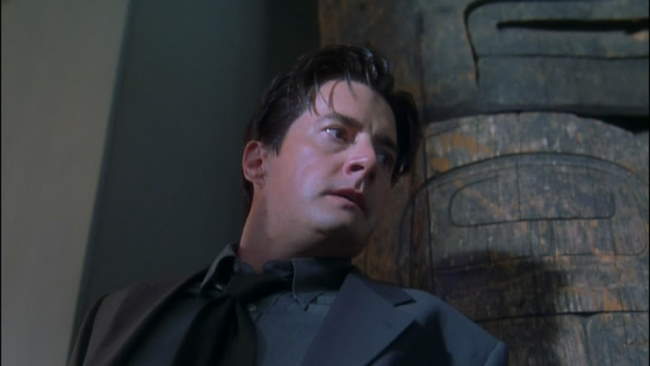
The CEO for Xchange (Janet Kidder) asks Toffler to take on the body of a clone until his real body is found. This is Tofflers’ worst nightmare. Considering clones only last a few days or so, Toffler freaks out and escapes. Strangely, he eventually gets someone to put him in a clone (Stephen Baldwin) anyways so that he can go out and find his body. From the moment Toffler escapes until the end, we get a completely bizarre and convoluted plot of corporate slimes treating the little people like trash, and screwing whoever they need to get to the top. I could go into details, but truly, for the most part it’s about as predictable as you can get.
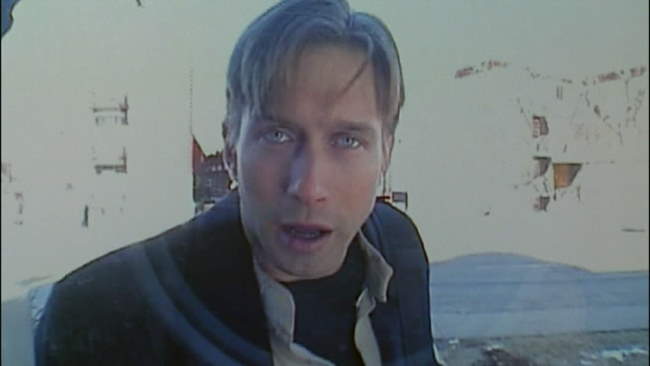
Scenes Too Stupid for Words: OK, Xchange is almost worth sitting through just to see the quick-cut shot of the CEO chick in the buff screwing the son bad guy while arguing about their absurd take over the world plan at the same time. The narrative called for the beans to be spilled on who the bad guys were, and why they were working together, so, for whatever reasons, they tried to combine the two scenes into one. Truly, this has to be one of the most idiotic sex scenes ever put on film. There are others in Xchange that are pretty bad, where similarly, something has to happen in the narrative but they couldn’t bother spending more than 10 minutes coming up with the details. But truly, the CEO sex scene has to be seen to be believed.
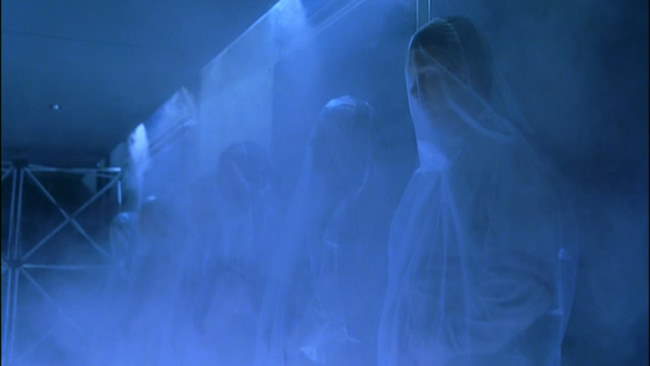
The Bottom Line: The mind transfer technology in Xchange could have potentially been interesting, but instead it is delivered in a completely simplistic and non-believable way. Worse, the surrounding story sucks horribly, and the acting, especially from Stephen Baldwin is pretty lousy. But again, the story idea was at least interesting, as was the bizarre floater bar. And the production values were at least on par with TV movies, so Xchange earns a solid 4 stars.
~See movies similar to this one~
Movie Review By: SFAM
Year: 2002
Directed by: Steven Spielberg
Written by: Philip K. Dick (short story), Scott Frank & Jon Cohen (screenplay)
IMDB Reference
Degree of Cyberpunk Visuals: High
Correlation to Cyberpunk Themes: Medium
Key Cast Members:
Chief John Anderton: Tom Cruise
Pre-Crime Director Lamar Burgess: Max von Sydow
Agatha: Samantha Morton
Danny Witwer: Collin Ferrel
Evanna (John’s Wife): Jessica Capshaw
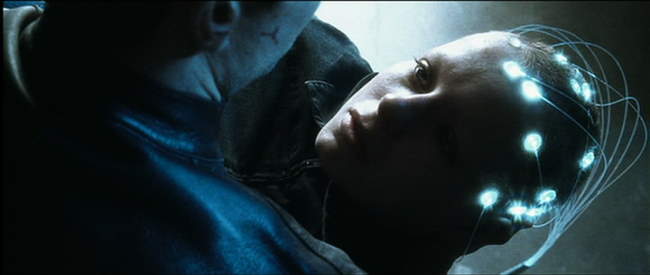
Overview: Minority Report, directed by Steven Spielberg, is another one of the large scale production cyberpunk movies that cleared a hefty gross (358 million worldwide, not counting DVD sales). Minority Report works both as a summer blockbuster (it was released in June), but also as a fairly intelligent cyberpunk flick. Based on another terrific story from Phillip K. Dick, Minority Report has a terrific cast headed up by Tom Cruise and Max Von Sydow, awesome special effects, and terrific music and sound FX throughout.
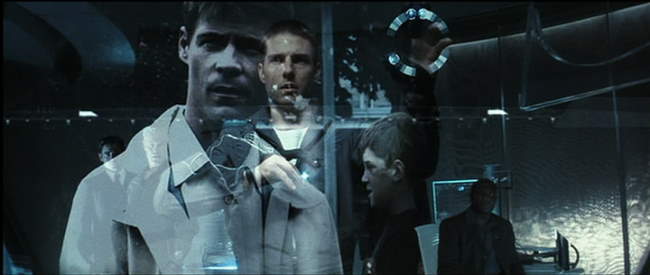
The Story: In Minority Report, Tom Cruise stars as John Anderton, a police chief at the head of an elite pilot police program, now in its sixth year, that prevents crimes BEFORE they are committed. The year is 2054, and the ability now exists within gifted, but altered people called “precogs” to tell when someone is about to commit a crime. The Precogs, comprised of two twins and one woman, Agatha (played wonderfully by Samantha Morton), are kept at all times in a dreamlike state in strange pool of water. The Precogs receive visions of murders that will be taking place. Based on an elaborate system that works off the Precogs, the police are able to extract the visions and are given the names of the murder victim and the murderer on color coded balls. Based on this, all premeditated murders have become a thing of the past – now the only murders that “might” take place are the crimes of passion, or “red balls” in Minority Report terms. When a red ball comes, the John Anderton must quickly work with the dreams to find the location of the murder (which often is only a few minutes or hours into the future) so that his team can rush to prevent it.
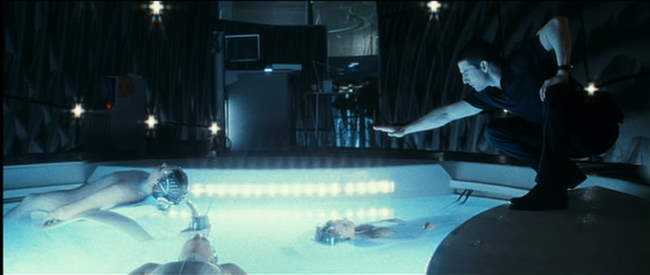
The end result of this technology is that people are being imprisoned for the crime PRIOR to committing it. Those who are identified by the Precogs are immediately sentenced to a strange virtual prison, where they are stuck in perpetual dreamstate (no word is given why they aren’t relegated to a normal prison). Through a quirky situation, John Anderton is brought in close proximity to the Precog, Agatha – she grabs him and fervently relays a vision that has occurred in the past. In tracking this down, John Anderton learns that sometimes one of the three Precogs actually deliver a vision that differs from the other two. This vision, termed a “Minority Report” is quickly discarded so as not to be seen as threatening the integrity of the process.
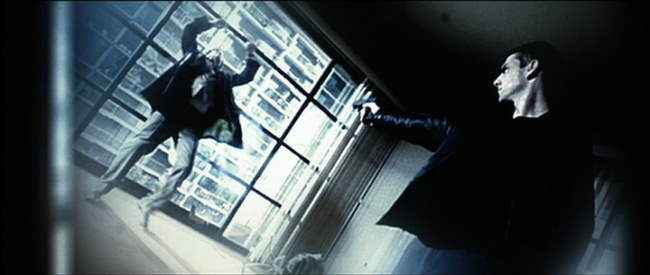
Anderton, plagued by the death of his son by an unknown assailant prior to the Precogs, has traditionally been the program’s biggest proponent. However, after learning of the Minority Report, he becomes concerned with the possibility that he has in fact been putting innocent people away. But unfortunately, his investigation into this matter has created powerful enemies. A new red ball vision is created, only this time Anderton finds out that HE is supposed to commit a murder in 36 hours. Convinced that he has been unfairly targeted, Anderton escapes from his former team and goes on a crusade to clear his name. His plight forces him to replace his eyes (used for retina scans at all security posts), and eventually takes him to the bottom of the Pilot Program’s seedy beginning.
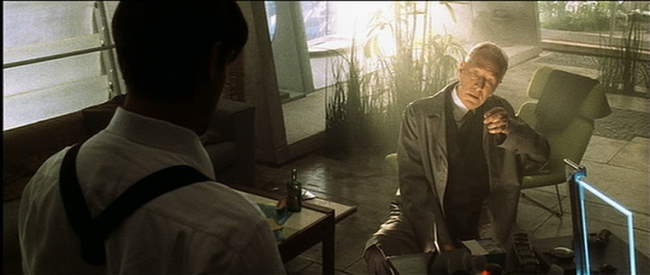
Story Issues : Nevermind the issue that the creepy hacker dude is able to jury-rig a vision scanning and extraction device faster than Scotty can fix a warp drive, Minority Report has a major issue with the technology that’s really never taken seriously – the issue of freewill. If precogs really can see into the future and determine that someone “will” murder their intended victim, this negates the ability of choice at that last instant of the murder. While this is eventually addressed (no spoilers), there is no rationale provided for why freewill was ignored. In the end we are left with believing that over-zealous law enforcement personnel were able to convince the entire country to take this approach. While this is a fine plot point, it would have been far more believable had their been some indication that they actually had to do a massive conving job.
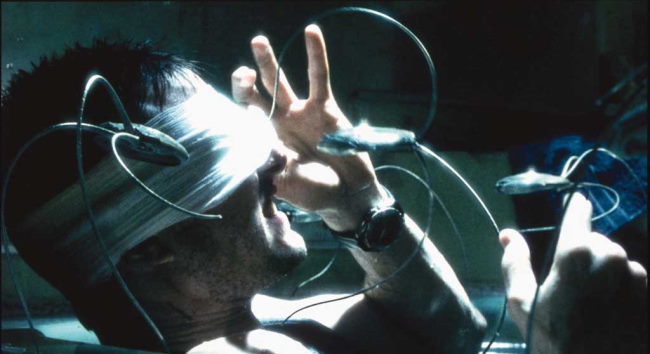
The Eyeball – the Ultimate Security Breach: The other issue with the story that really defies believability is that when John Anderton is caught, he is CONTINUALLY able to get back into the most secret areas of Police HQ by using his former eyeballs, which he keeps with him in a plastic baggie. Even though the police know he’s on the lamb, the apparently don’t feel the need to revoke Mr. Anderton’s security access privileges. This is all the more disbelievable considering EVERYTHING in society is apparently keyed off a retina scan. Sure, OK, perhaps one time they lapse on this, but three times??? Common Steven – you’re too good a story teller to let that one slide.
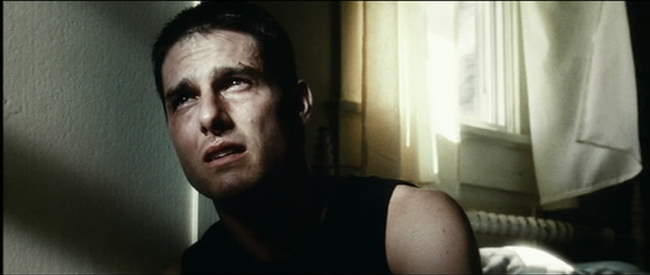
The Visuals: The visuals are sleek and well integrated, with some nice aqua and blue tones throughout. Interestingly, Spielberg usually goes with an overexposed type of shot to make it look almost as if one is looking at a dream sequence. Continually, we get white saturation dominating the shots. While this approach sounds weird, it ends up working wonderfully in adding to the mood of a cyberpunk film that has a massive focus on visions and dreams. As always, Spielberg gives us a plethora of truly unique visuals and mood shots. The best of the movie comes when Agatha
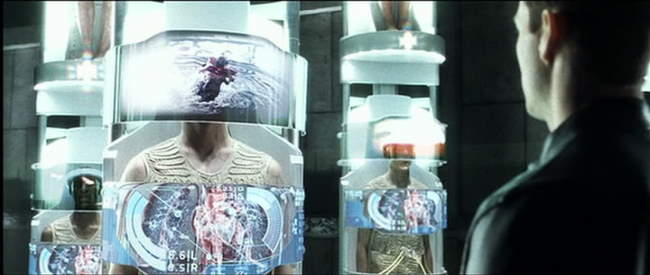
The FX: Minority Report consistently has absolute top-notch FX that adds interesting elements to the story. From the strange spider surveillance things, to the Boba Fett Police Podships, to the mixed modern cityscapes, the world of Minority Report comes off as a truly odd cyberpunked future. At some level, everyone seems to be living normal lives. Yet every now and then, we get a sense that the surveillance society has taken hold to the point that people have all just accepted it.
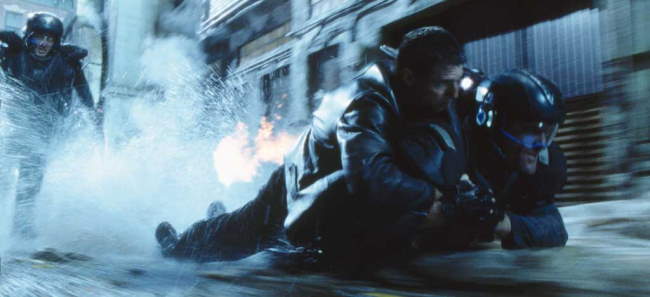
The Bottom Line: The overall mood and FX in Minority Report are terrific. The acting is great - Cruise has rarely been better, but also Von Sydow as the Police Director, Collin Ferrel as the scheming FBI agent, and Samantha Morton as the Precog are all terrific. The FX and sound If you buy the technology, chances are you give Minority Report at least a 9 or 10 star rating. Unfortunately, I did have problems buying some of this. Regardless, the story issues don’t take too much away from a very worthy cyberpunk film.
Page 2: More Screencaps–>>
~See movies similar to this one~
|
















































































































